Quiche is an essential feature of most British picnics, but we too often opt for the same old options. Try shaking things up with this creamy red onion and chestnut quiche.
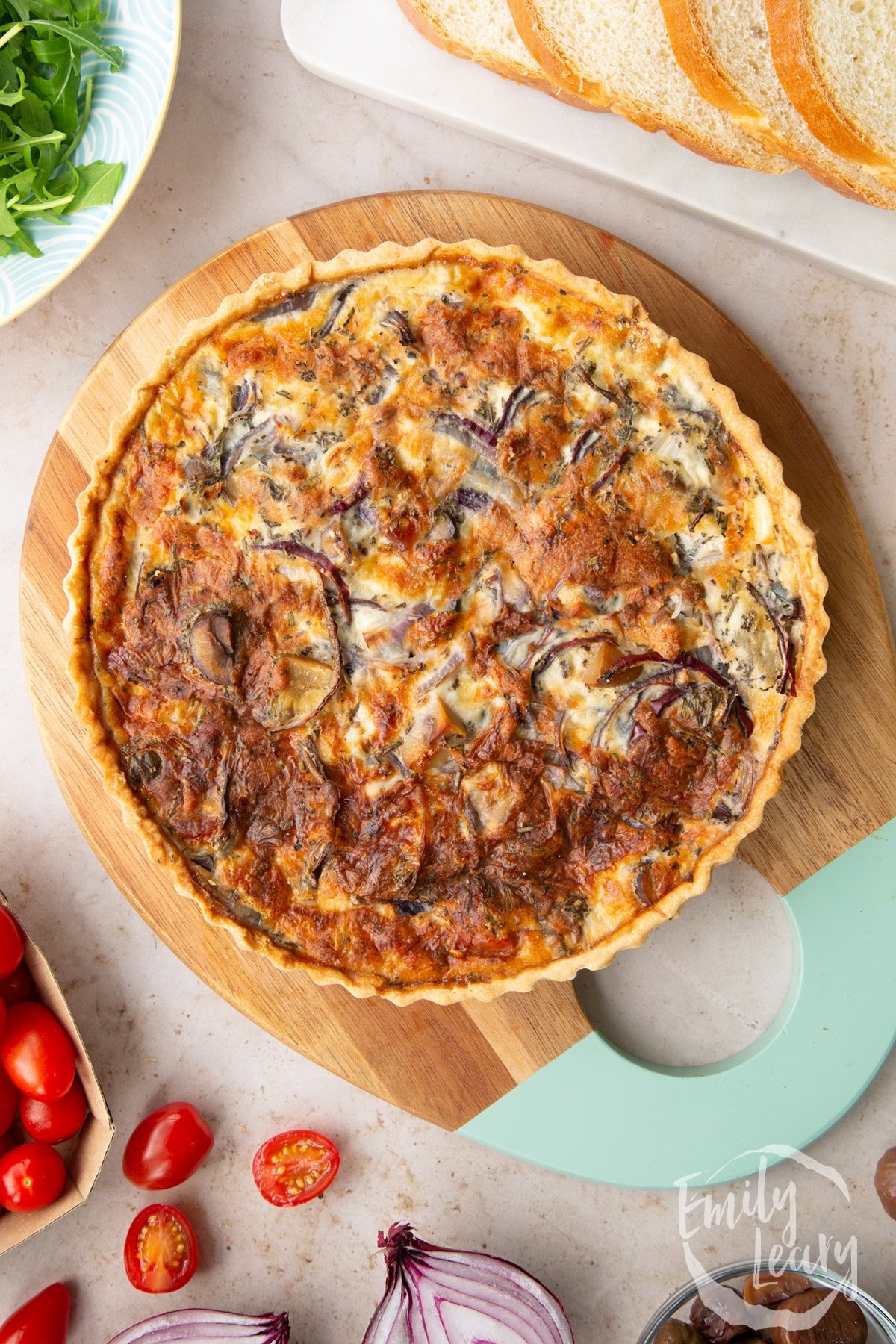
Chestnuts are easy to cook with, versatile, and can add texture, flavour, and are a source of antioxidants. They're an easy way to pep up your tasty, and healthy home cooking.
Best of all, this chestnut quiche is really easy to make, utterly delicious and completely perfect for a summer lunch.
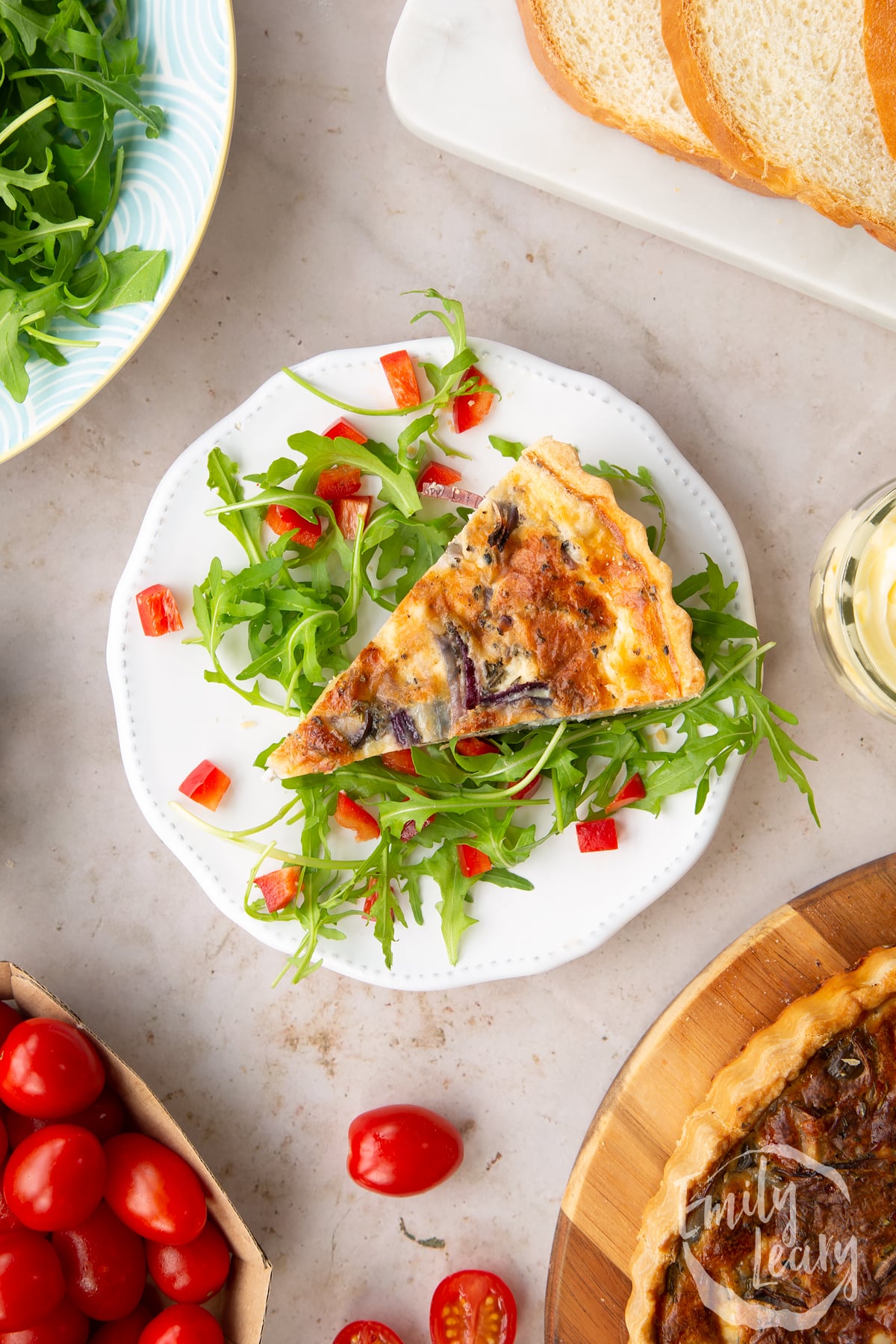
To make the shortcrust pastry, you'll just need butter and flour, which you can rub together either by hand, or with a short spin in the food processor. Add a little water and you'll have a lovely, pliable pastry, perfect for lining your flan tin.
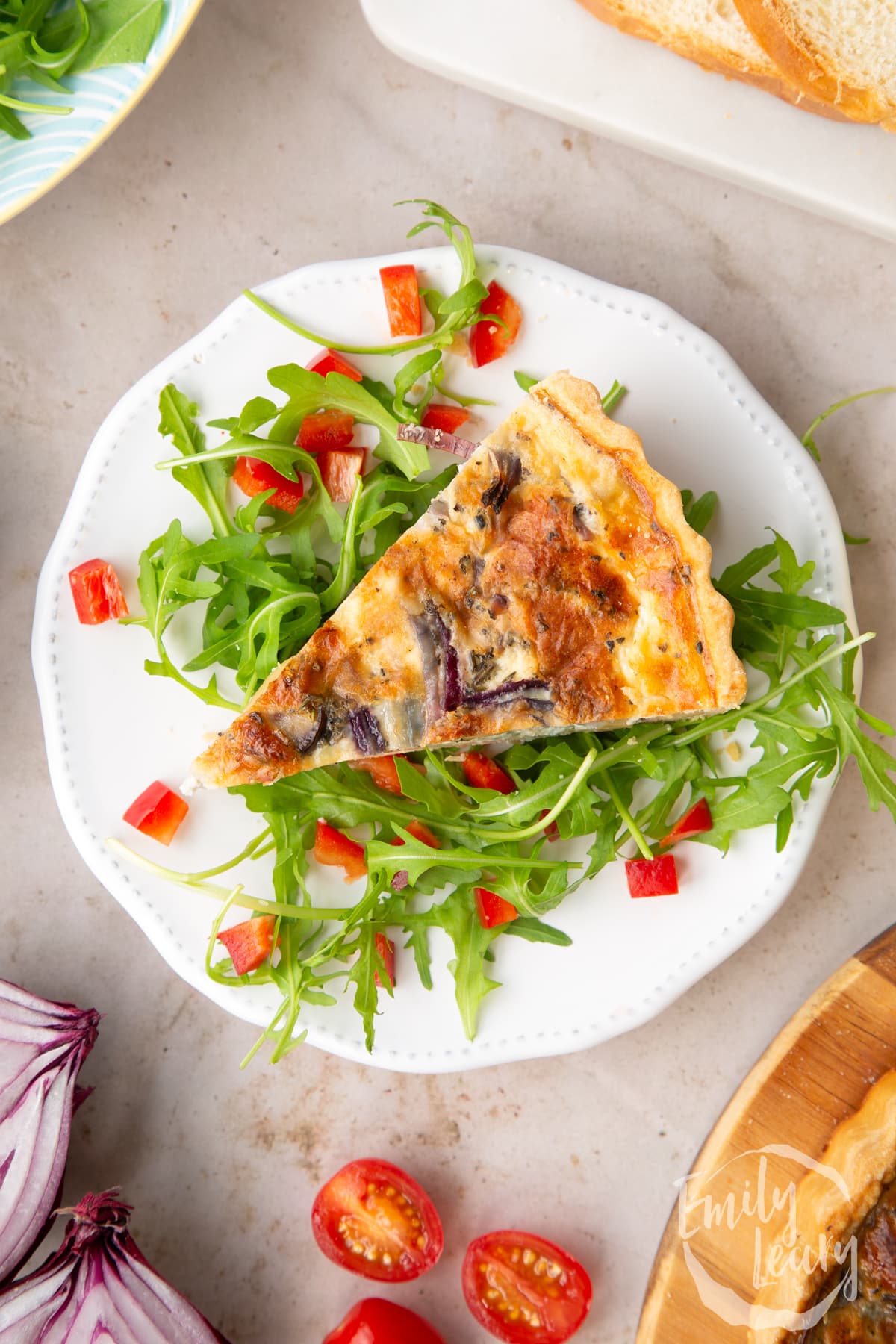
There are loads of pics and tips in the full recipe below, so you'll find lining your tin a total breeze. You'll also learn how to blind bake, which means giving the pastry a bit of time in the oven without its filling, so that it can crisp up beautifully with no risk of a soggy bottom!
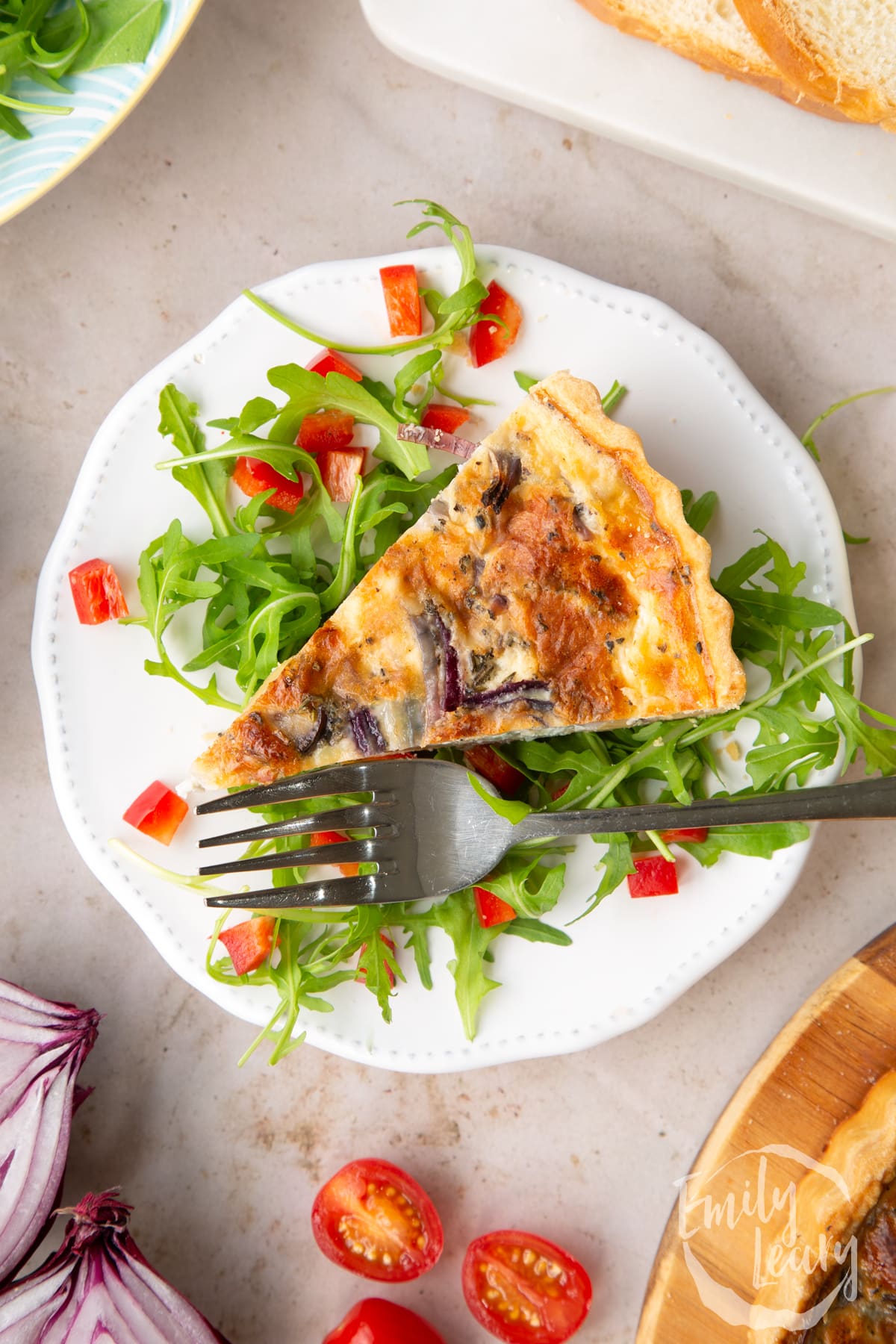
The filling is a lovely, flavoursome blend of sweet, moreish chestnuts, sliced red onion, cheddar cheese, fragrant rosemary and, of course, plenty of eggs and milk to give a beautiful, perfectly set finish.
Here's how to make my yummy chestnut quiche.
Ingredients
For the pastry
- 200 g (7.1 oz) plain white flour (all purpose flour) all purpose flour
- 100 g (3.5 oz) slightly salted butter
- 2 tbsp water
For the filling
- 180 g (6.3 oz) whole chestnuts quartered
- 1 red onion thinly sliced
- 5 g (0.2 oz) rosemary stalks removed, finely chopped
- 4 medium free range eggs
- 300 ml (10.1 floz) whole milk
- 40 g (1.4 oz) cheddar cheese vegetarian if required grated
Instructions
Make the pastry case
Put the flour and butter into a bowl.
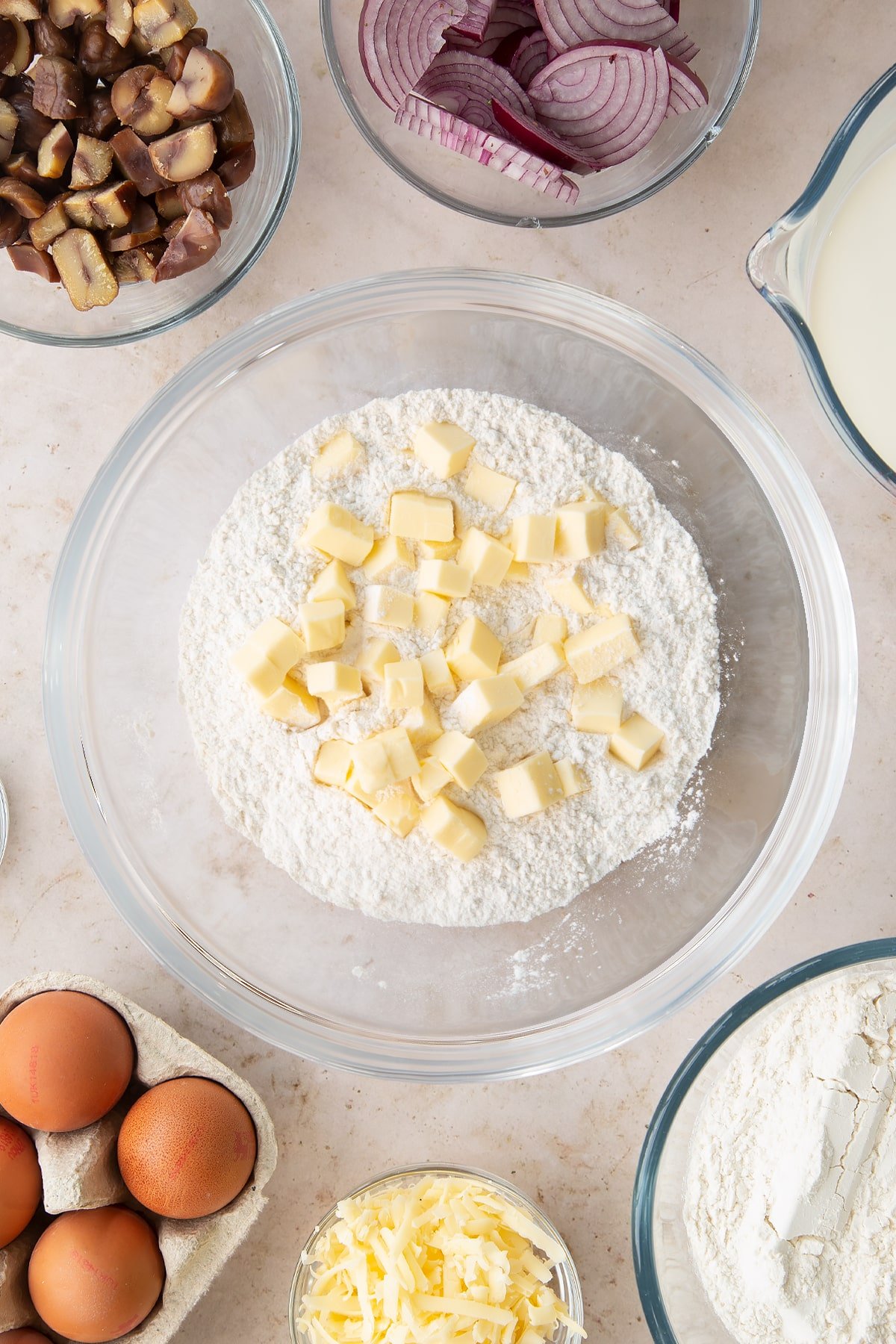
Rub together quickly and efficiently until you have something resembling fine breadcrumbs. You can do this by pulsing in a food processor, if you prefer.
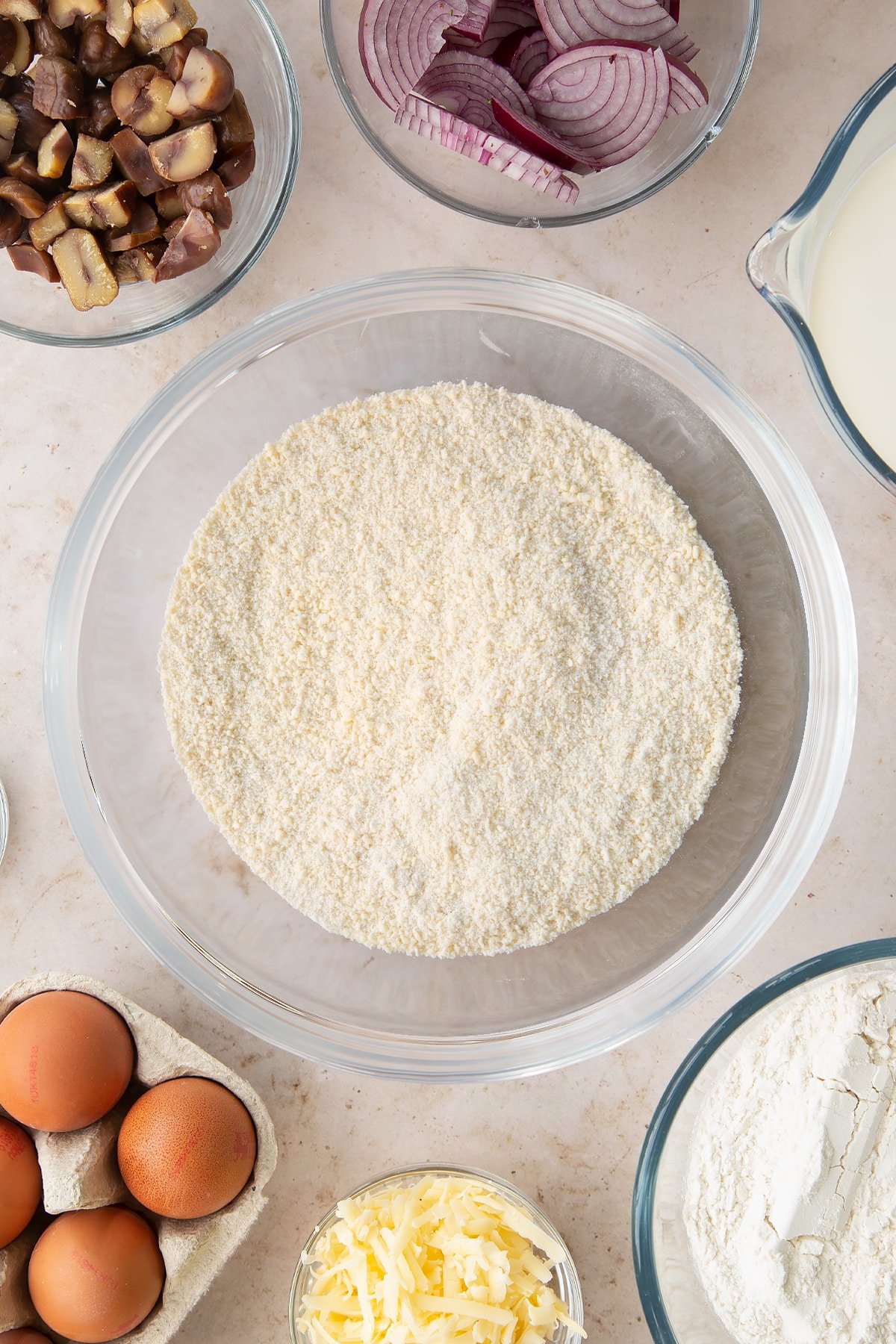
Add the 2 tbsp of the water.
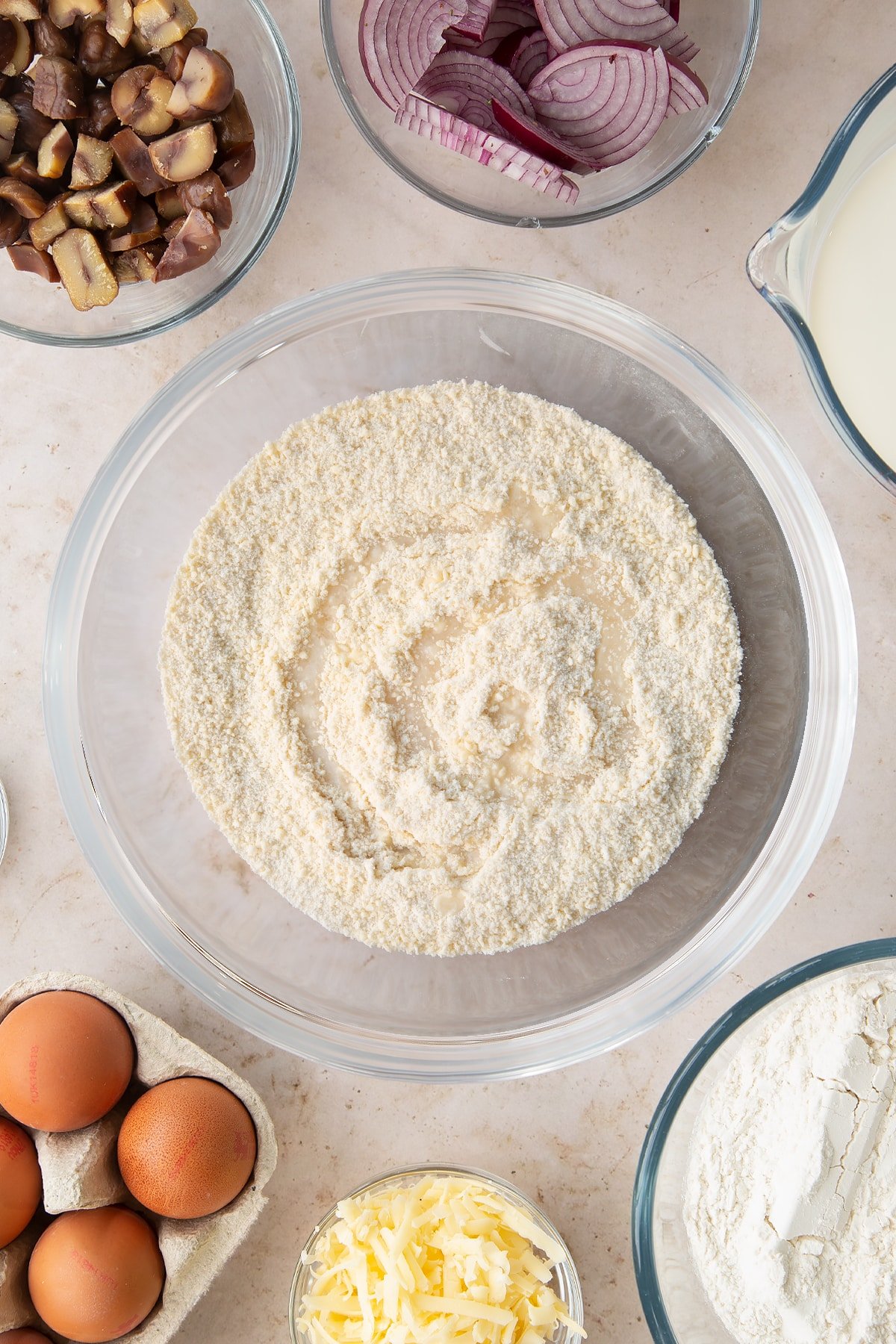
Cut the liquid through the crumb with a cutlery knife. If it still seems really dry, add another drop or two but try not to add more as a wet dough may result in a tough pastry or a soggy bottom.
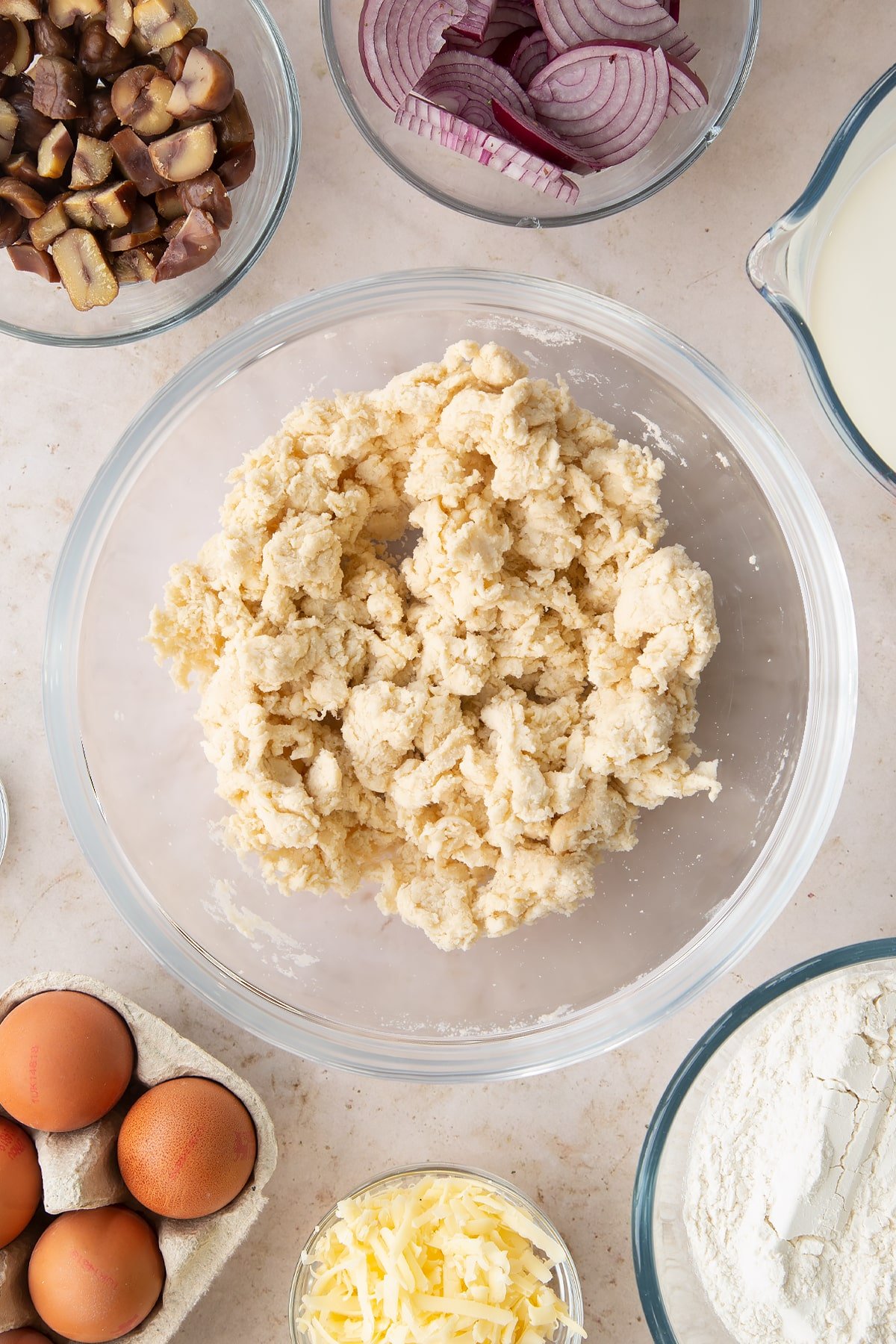
Form the pastry into a ball.
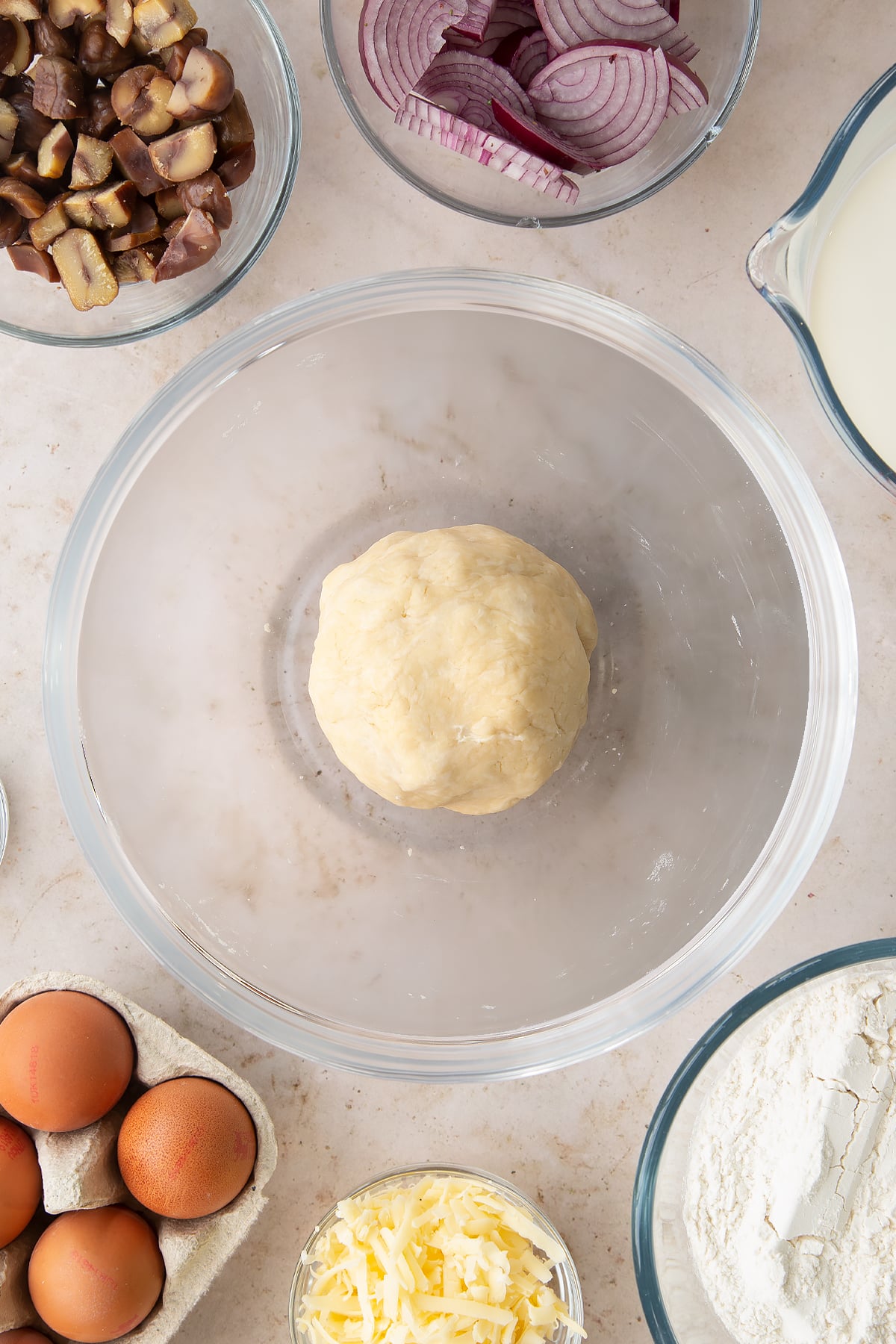
Shape the pastry quickly into a flat disc, wrap and pop in the fridge for at least 10 minutes to firm up.
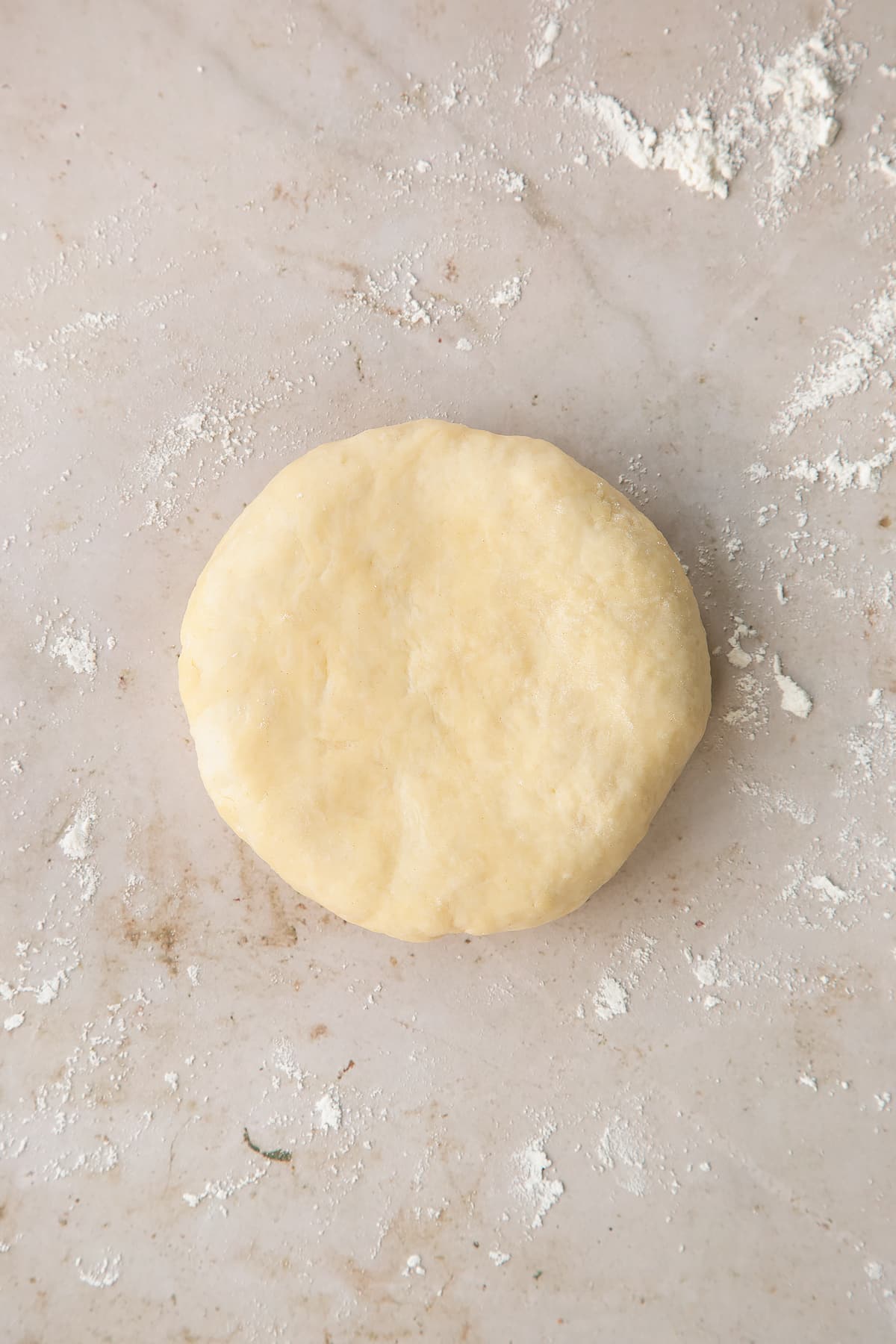
Preheat the oven to 210C (190C fan-assisted).
Roll out the pastry so that it’s 3-5cm (1-2 inches) wider than your tin.
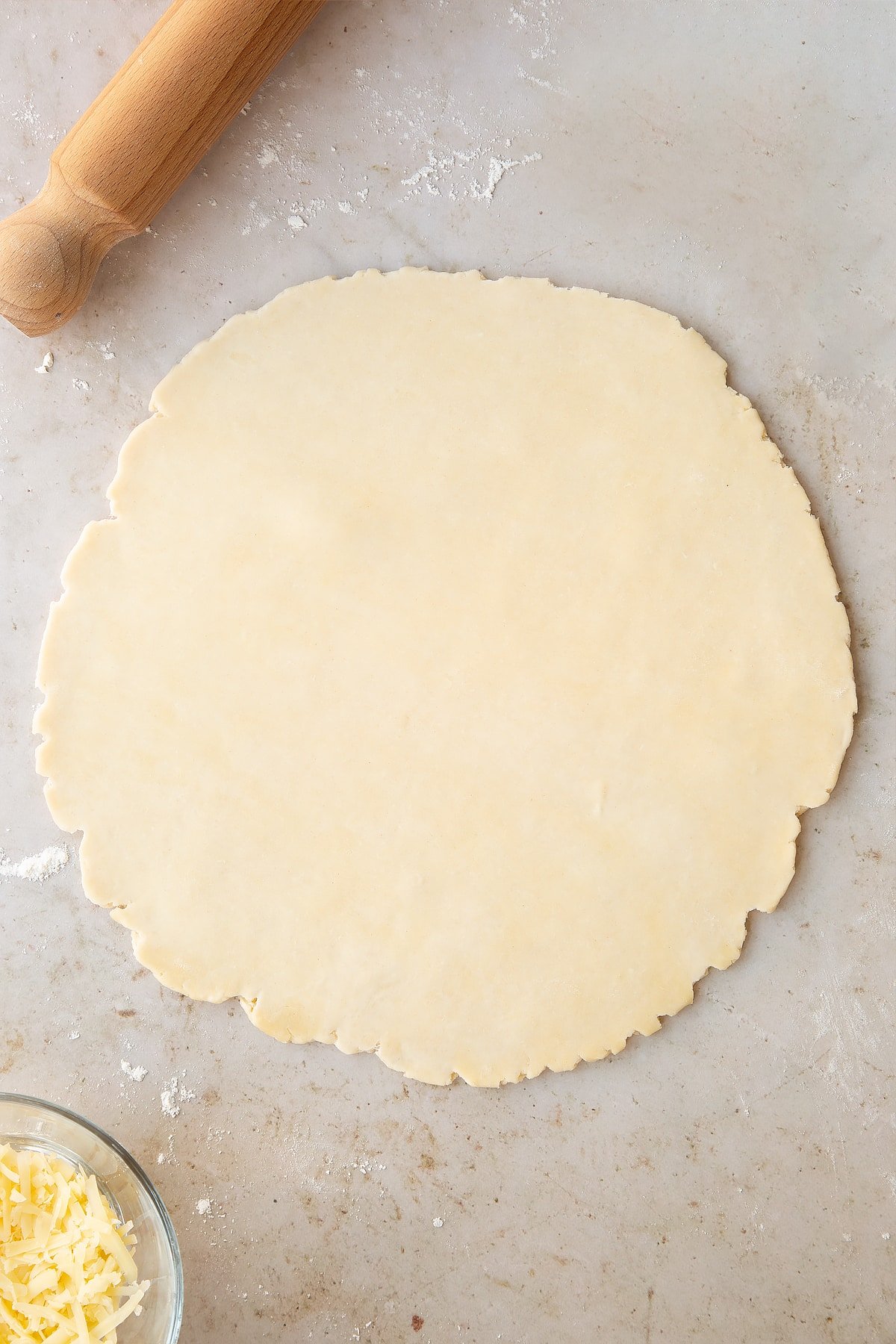
Lift it into the tin, press into the corners so that there are no air gaps.
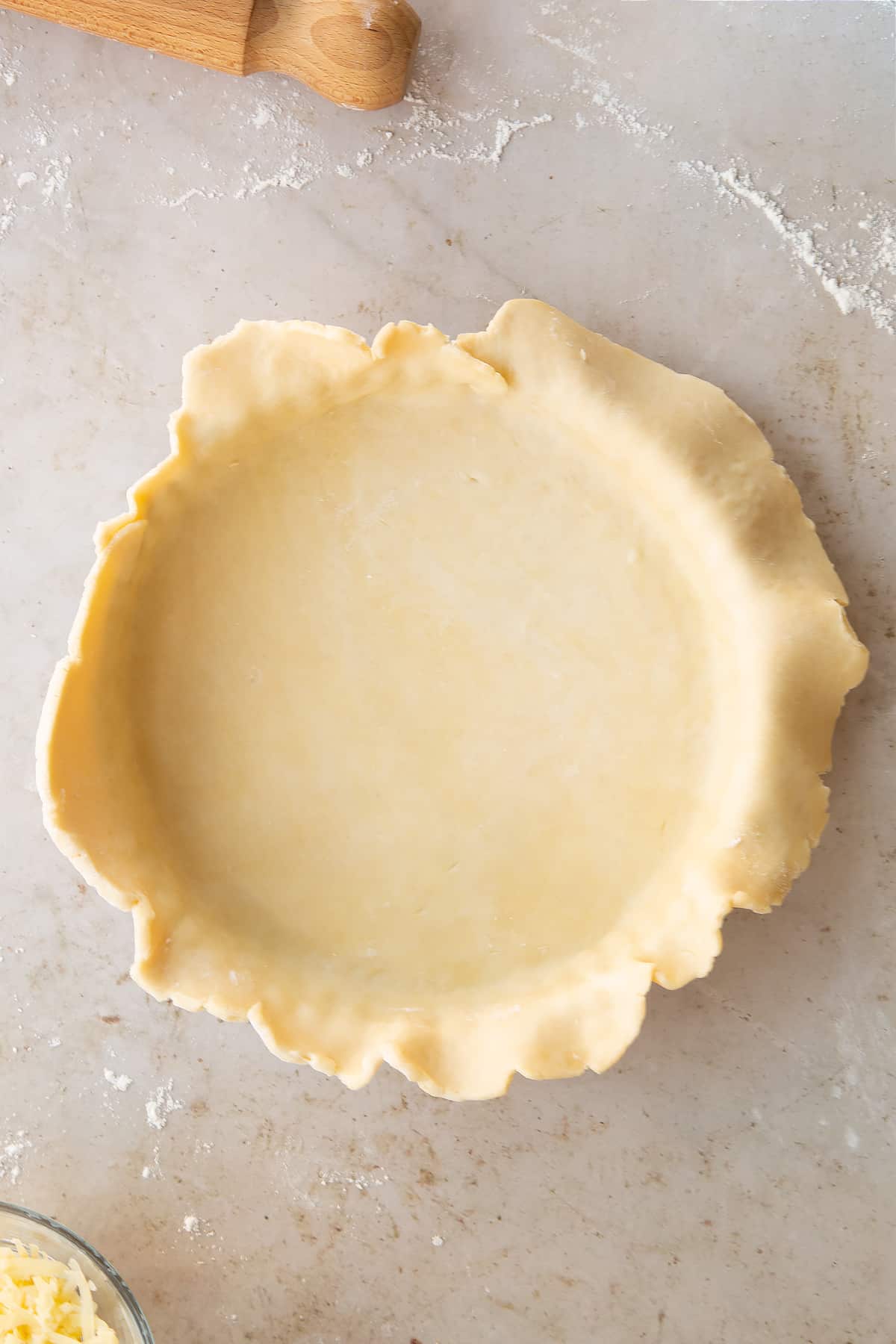
Roll a rolling pin over the top of the tin.
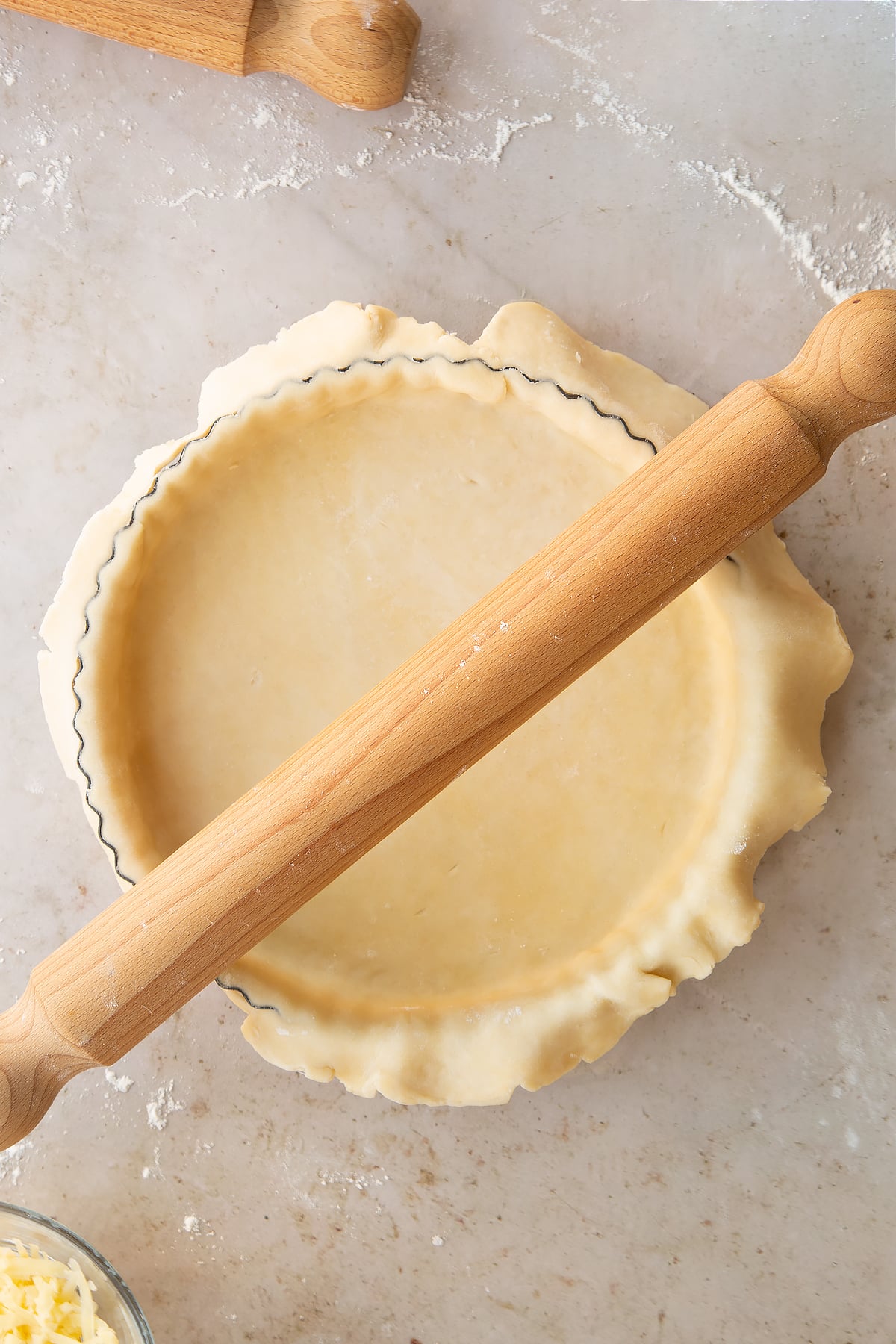
This will trim off the excess.
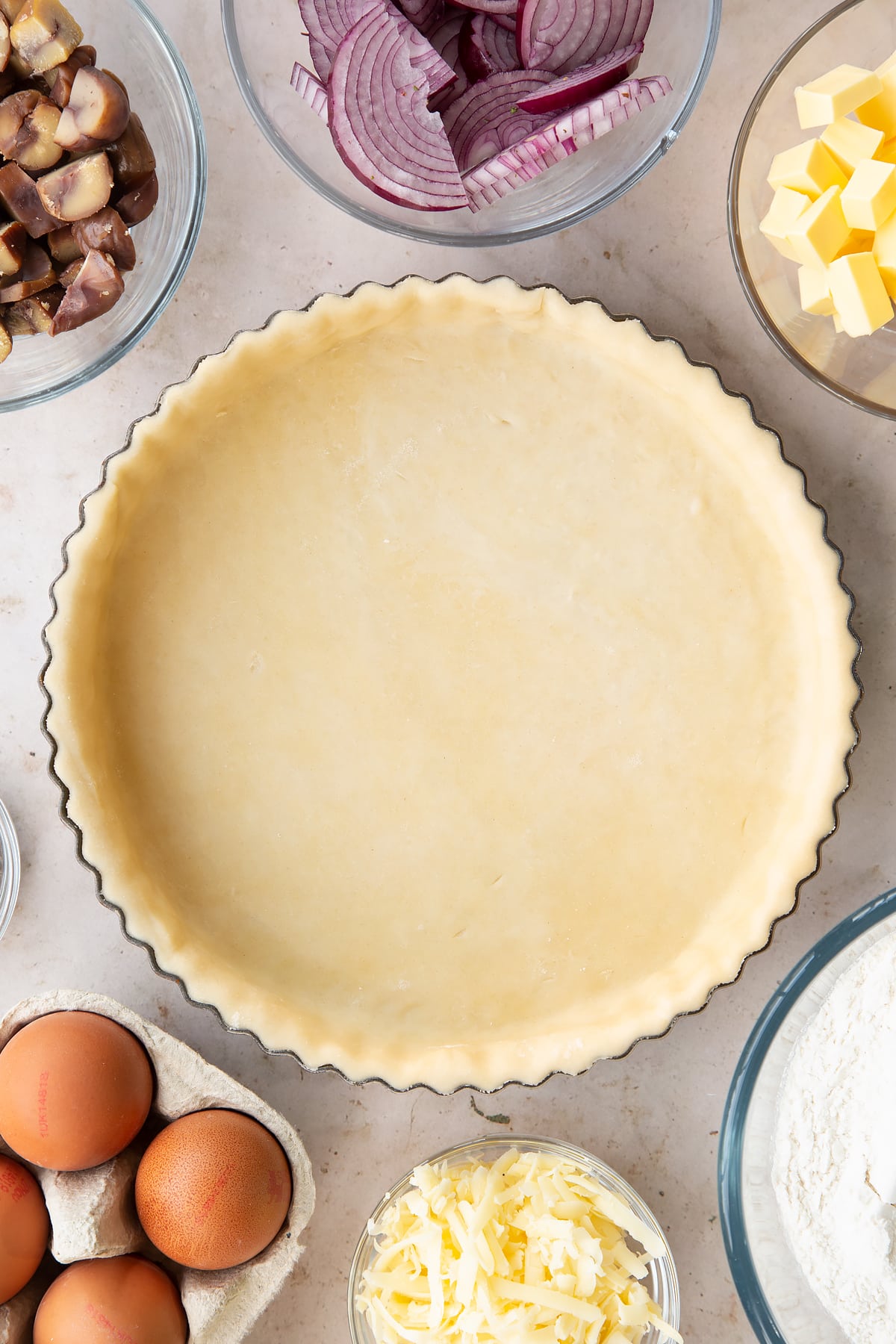
Scrunch up some baking paper and use it to closely line the inside of the pastry case.
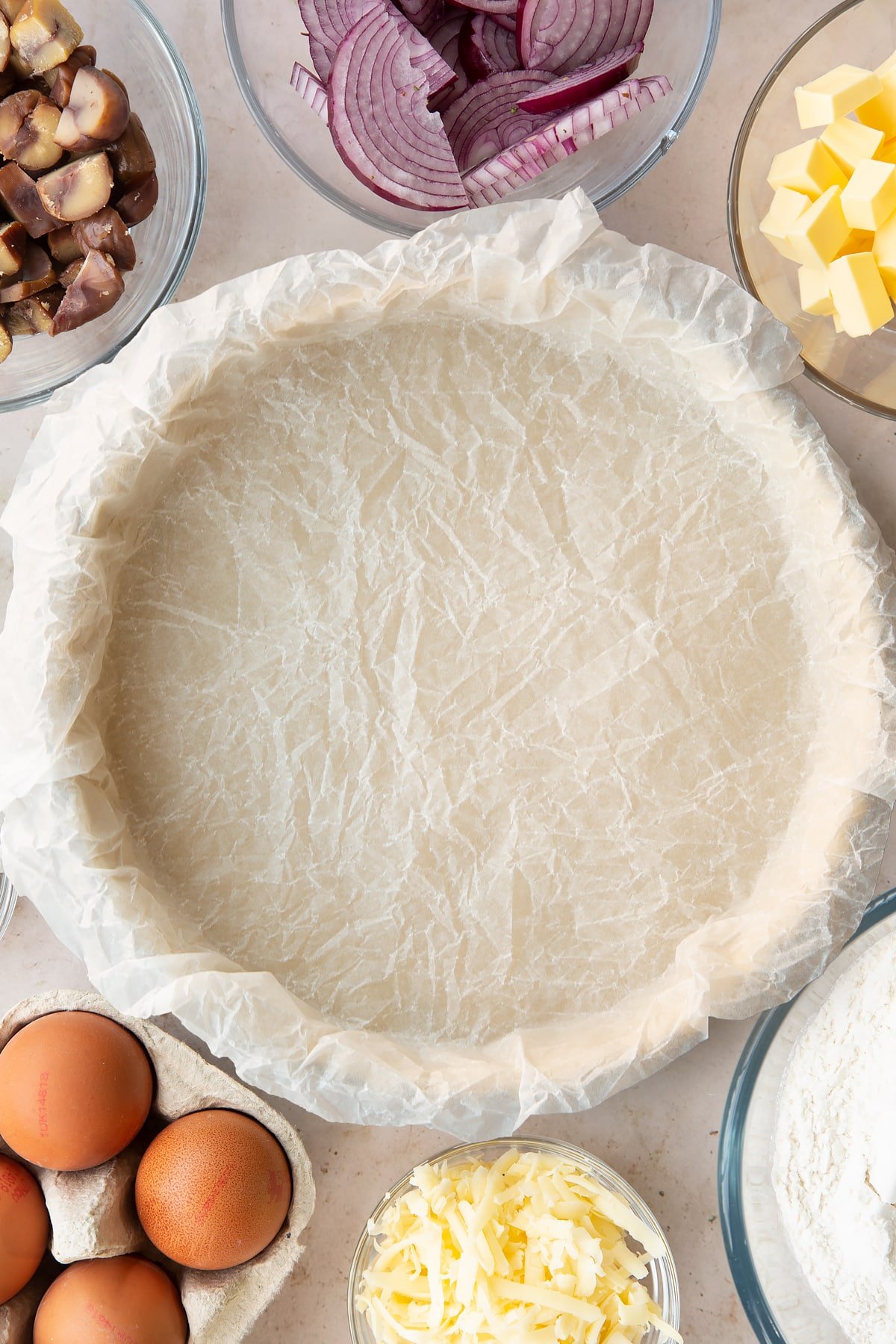
Fill the paper with baking beans making sure to work them into the corners.
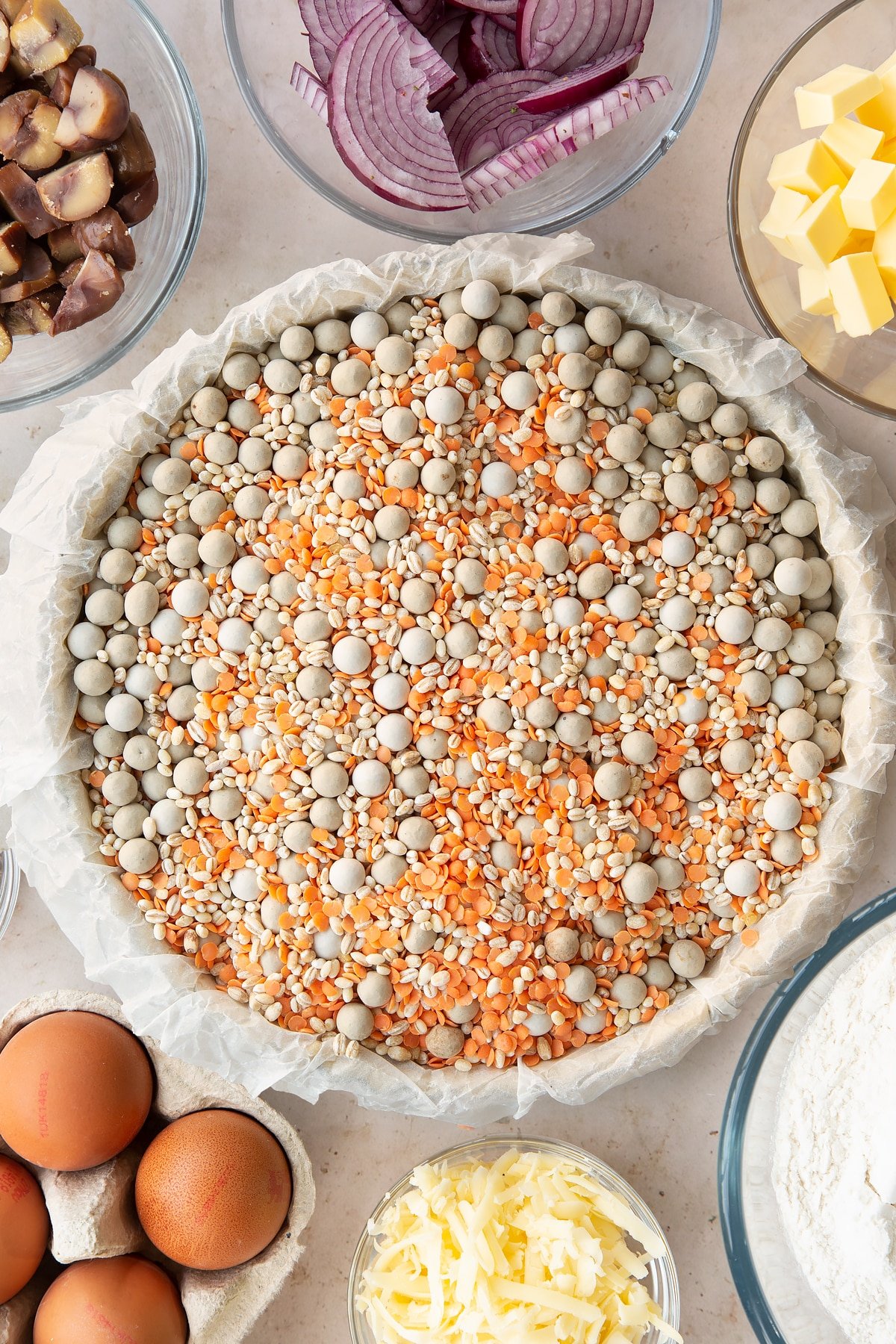
Place the tin in the oven and bake for 15 minutes. Lift out the baking paper with the beans (careful, they’ll be very hot) and have a look at your pastry. It should look dry at the sides but will probably still be a bit doughy on the base.
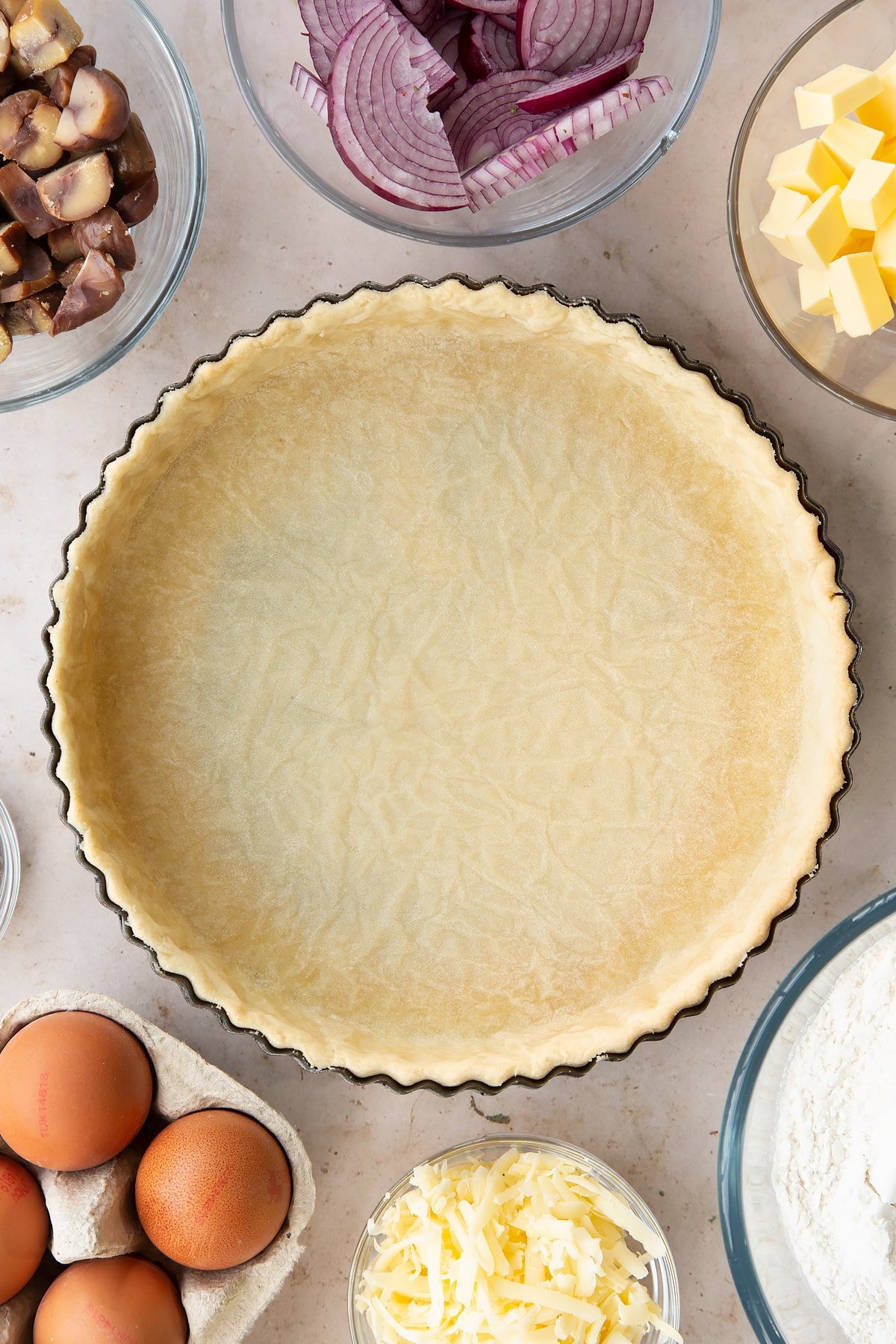
Return to the oven and bake for a further 5 minutes. If there are any air bubbles on the base, you can gently smooth them down with the back of a spoon.
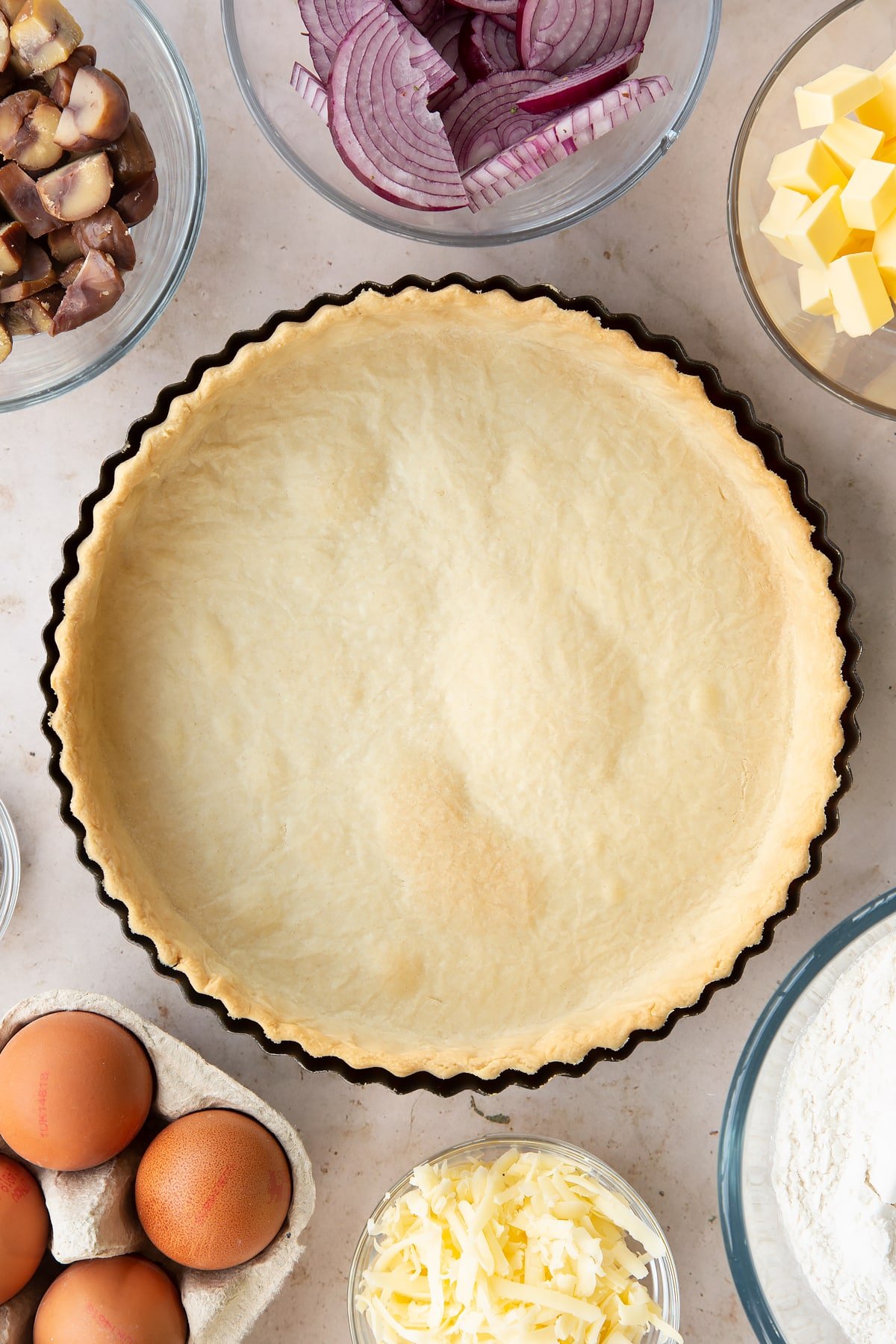
Make the filling
Lower the oven temperature to 190C (fan 170C) and place a flat tray on the shelf (this will help ensure the base is well crisped.
Spread the red onion and chestnuts evenly on the bottom of the pastry case.
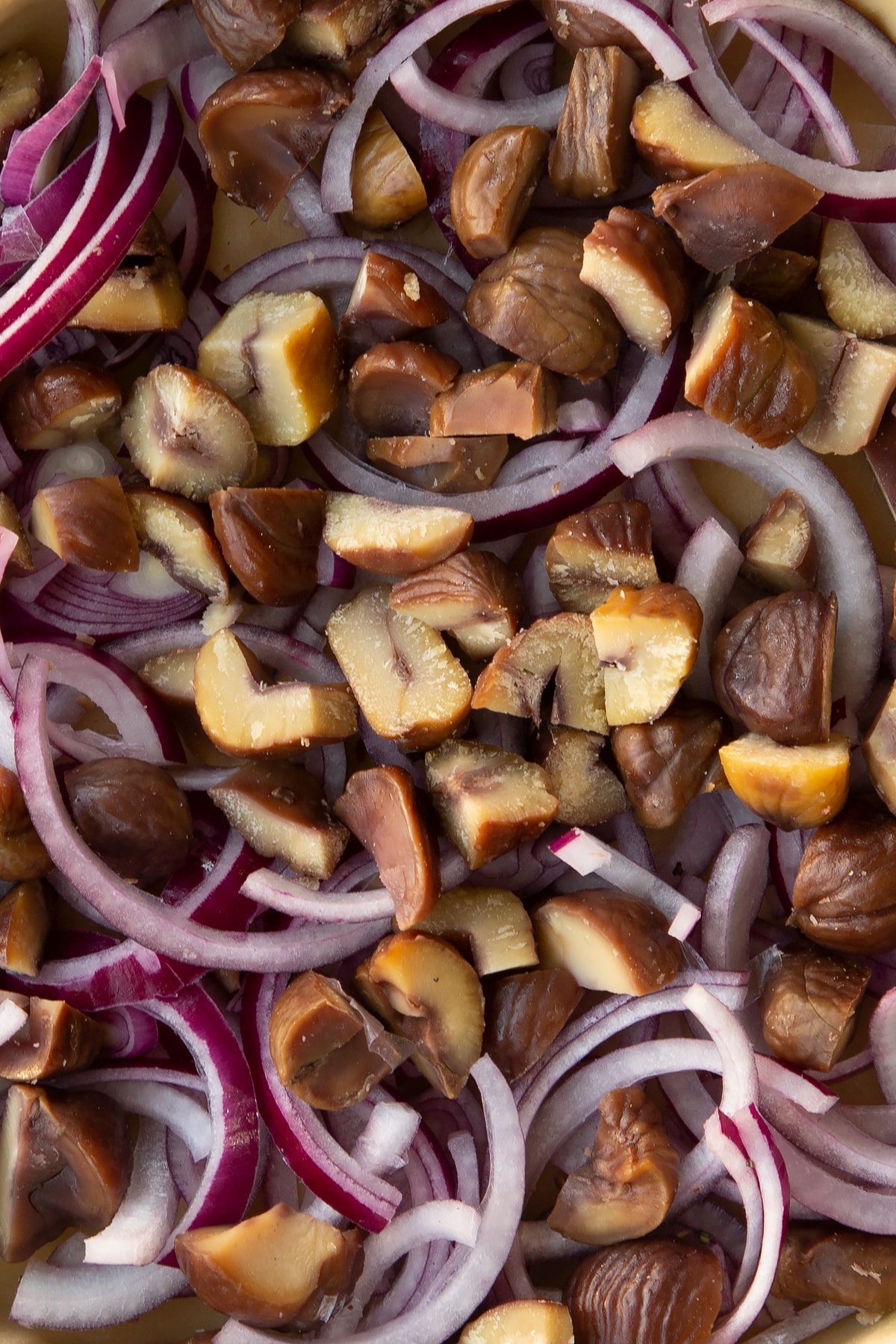
Sprinkle the grated cheese on top, then the rosemary and a good pinch of salt and pepper.
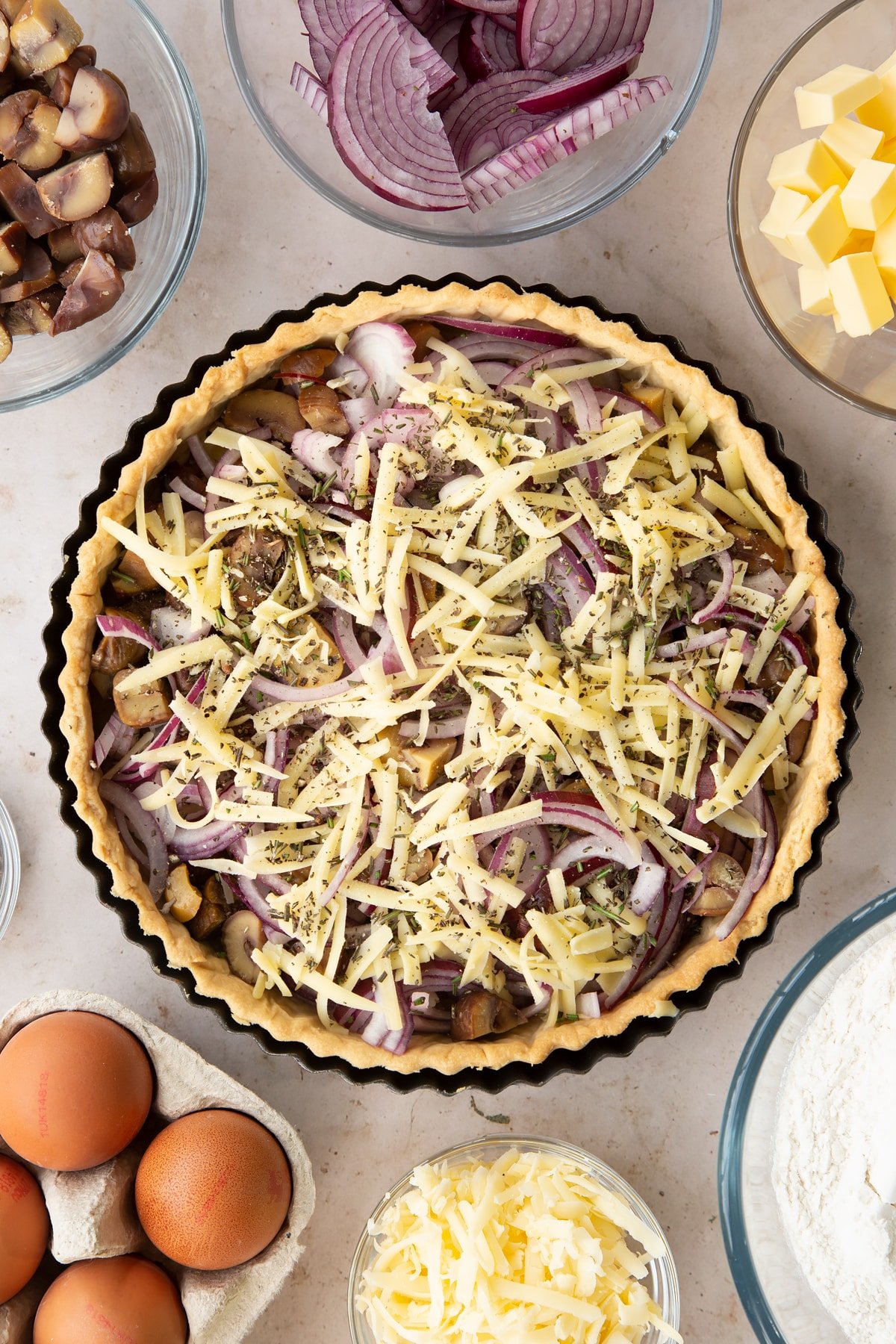
Put the eggs and milk in a jug.
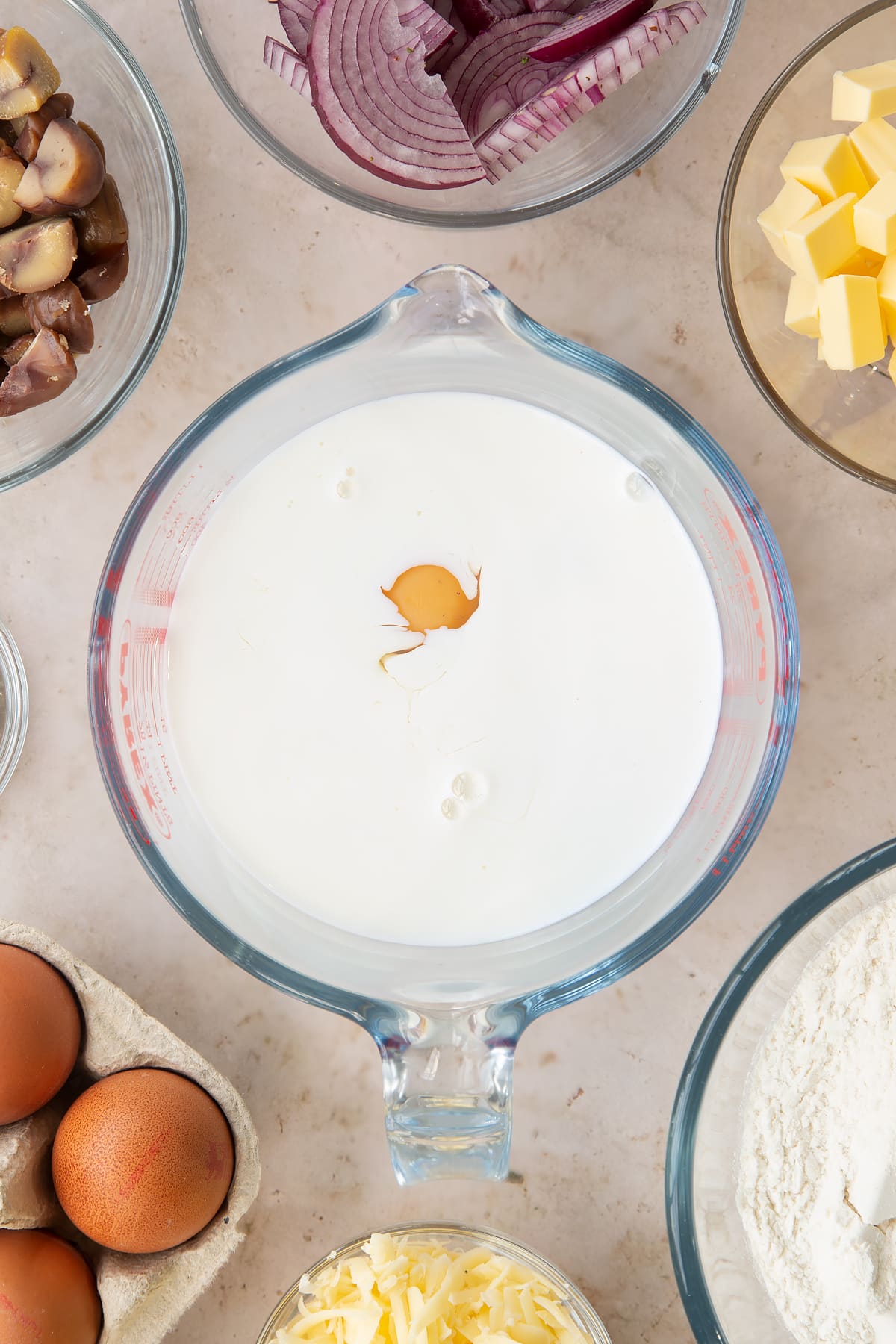
Beat them together.
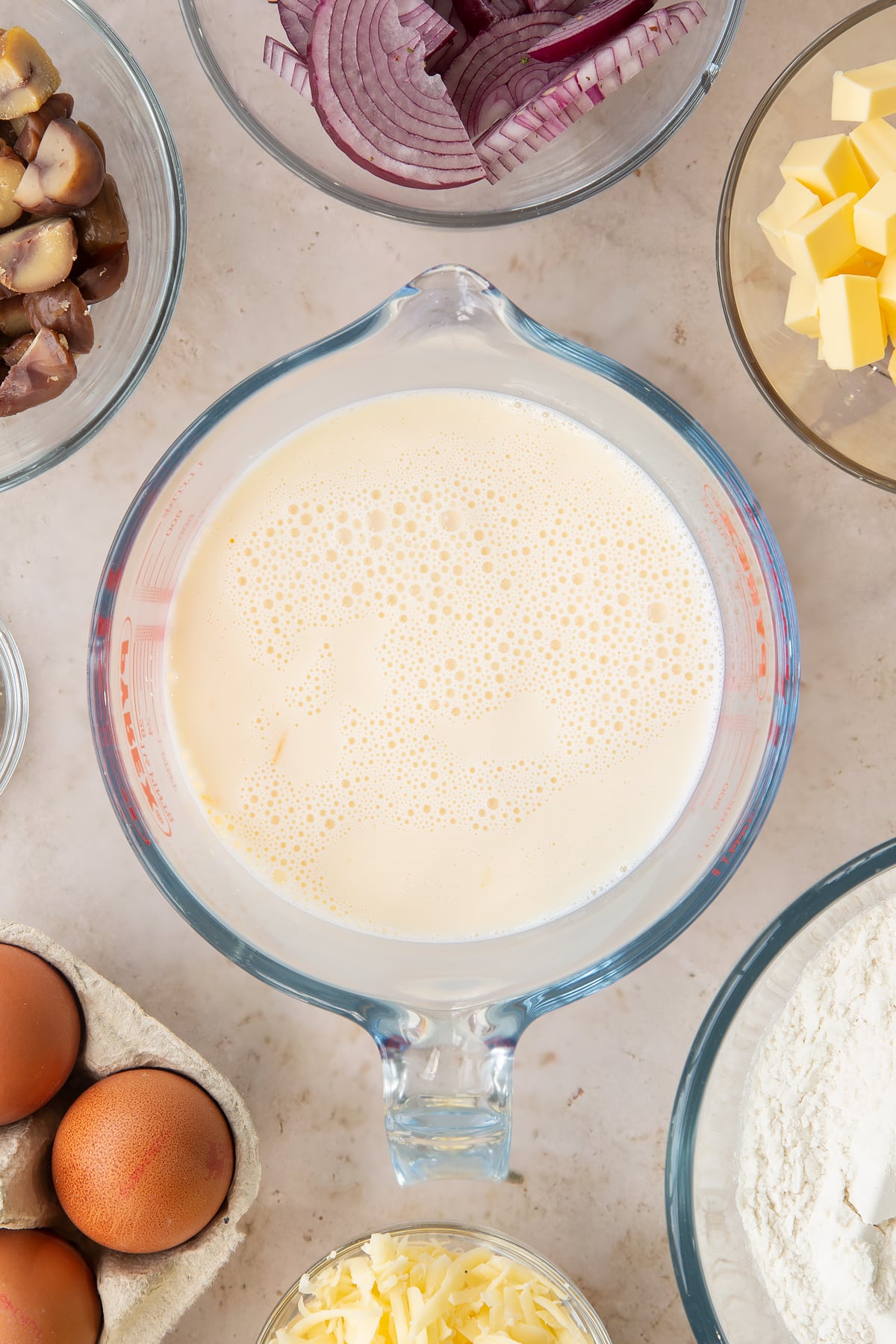
Pour the egg mixture into the case. Depending on the size of your tin, you might not need all of the egg and milk mixture. Don't fill it closer than a centimetre or so (half inch) from the top.
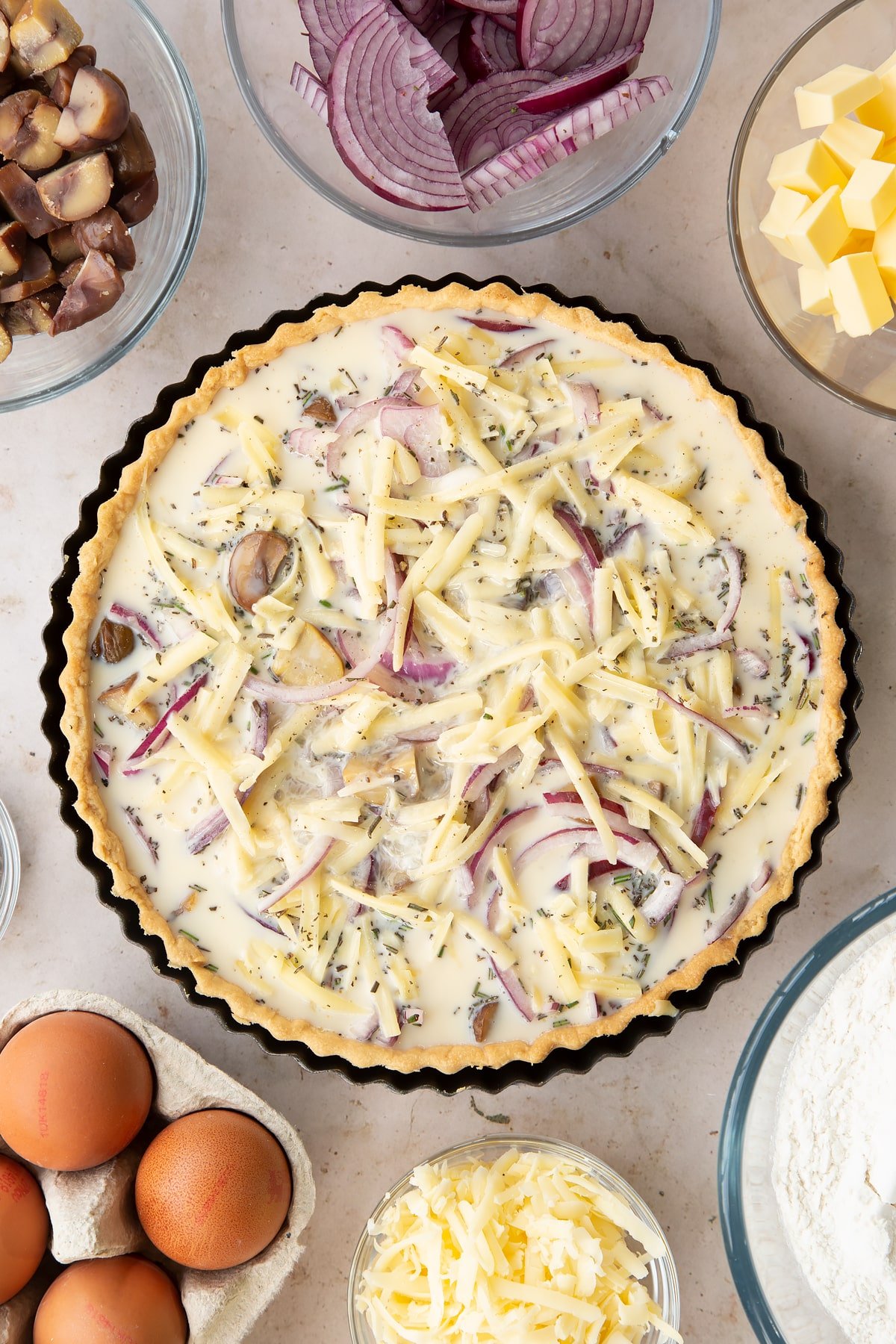
Bake for 45-60 minutes until the pastry is crisp and golden and the quiche feels set to the centre if gently pressed with a finger tip.
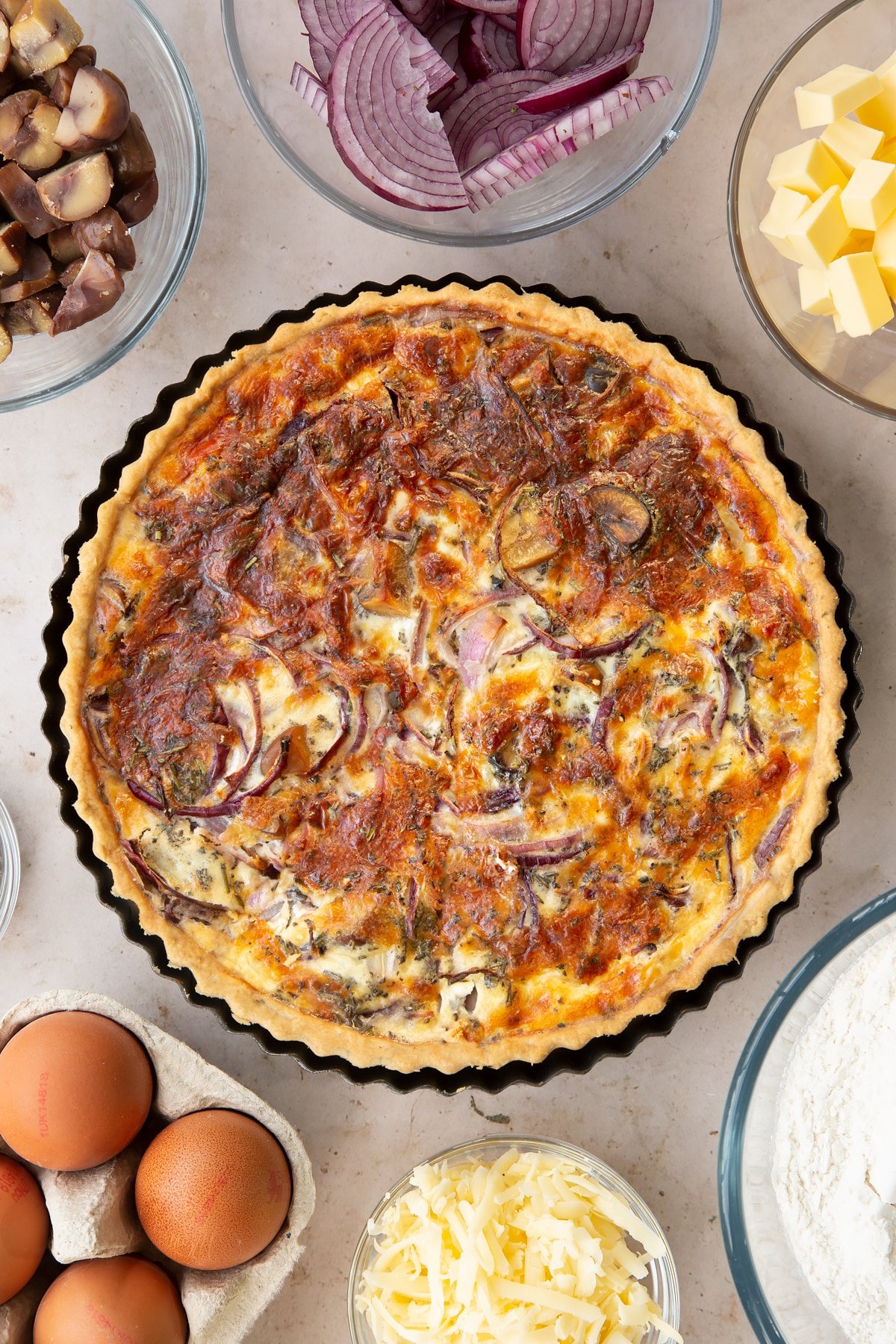
Place the flan tin on a can and the sides should drop away. Transfer the quiche to a cooling rack.
Looks yummy, right?
Pointers, tricks and troubleshooting tips for the perfect Chestnut quiche
Is Chestnut quiche easy to make?
Yes! This Chestnut quiche is a surprisingly easy recipe to make for the impressive results that you'll get.
The pastry element of this recipe is a shortcrust pastry recipe, which means you don't have to do any complex layering of butter as you would with puff pastry, and you don't have to worry about kneading the dough. Instead, all you have to do is bring the pastry ingredients together until it's a smooth ball.
Once your pastry is ready, you simply roll it out and fit it into the quiche tin. Don't worry about rolling it out to fit the tin because you can just slice the excess pastry from the edges. Or, to get a clean edge to your quiche, you can roll over the pastry tin edges with a rolling pin, and the excess pastry will fall away. For more help, I’ve written a whole post full of tips to help you line a pastry tin!
When your pastry is snug in the quiche tin, it needs to be blind baked, which isn't as scary or technical as it sounds. Blind baking is the process of baking a pastry case with no filling, so it doesn't get soggy when you add the filling to it later.
To blind bake your pastry case, just pop a layer of baking paper over the pastry in the tin, then pour in a bag of baking beans/ rice/ lentils/ dried beans to weigh down the pastry as it cooks. Weighing down the pastry during blind baking is essential for a smooth pastry case. Otherwise, the pastry could rise in certain areas and leave you with an overflowing quiche!
Now that your pastry case is ready, you'll need to move on to the filling. The good news is that the filling is even easier than the pastry, so you will have completed the most technical elements of the recipe by this stage!
The filling is a creamy, dreamy combination of eggs, milk, cheese, onion and chestnuts, which cooks in the pastry case. So all you have to do is neatly chop up the onions and chestnuts and add them to your cooked pastry case. Then pour over the cheese and eggs and bake the assembled for less than an hour!
If you've never cooked with chestnuts before, don't worry! You can buy chestnuts that have been pre-cooked and shelled, which means you only need to slice them into quarters.
Chestnuts are a really versatile ingredient, they’re nutty with a natural sweetness so you can use them in sweet or savoury dishes or eat them on their own. So this chestnut quiche could be eaten cold at a Summer picnic, or fresh from the oven as a hearty hot dinner on a cool Autumn evening.
Will I need any special equipment to make Chestnut quiche?
This Chestnut quiche recipe is super simple, so the only equipment you might not have for this recipe is the loose bottom quiche tin and baking beans. You can usually find a quiche tin and baking beans in a large supermarket. If you can't find them in-store, don't worry!
There is a full list of suggested equipment on the recipe card below with links to the best products to use on Amazon.
Where can I buy chestnuts?
Chestnuts are a traditional Christmas snack, so during the festive period, you can usually find chestnuts in most supermarkets or food stores.
However, as I said chestnuts are really versatile and are delicious all year. So if you’re making this recipe in the Summer, don’t worry! You can usually find pre-cooked and vacuum-packed chestnuts on the baking aisle or with dried fruits and nuts in your local supermarket.
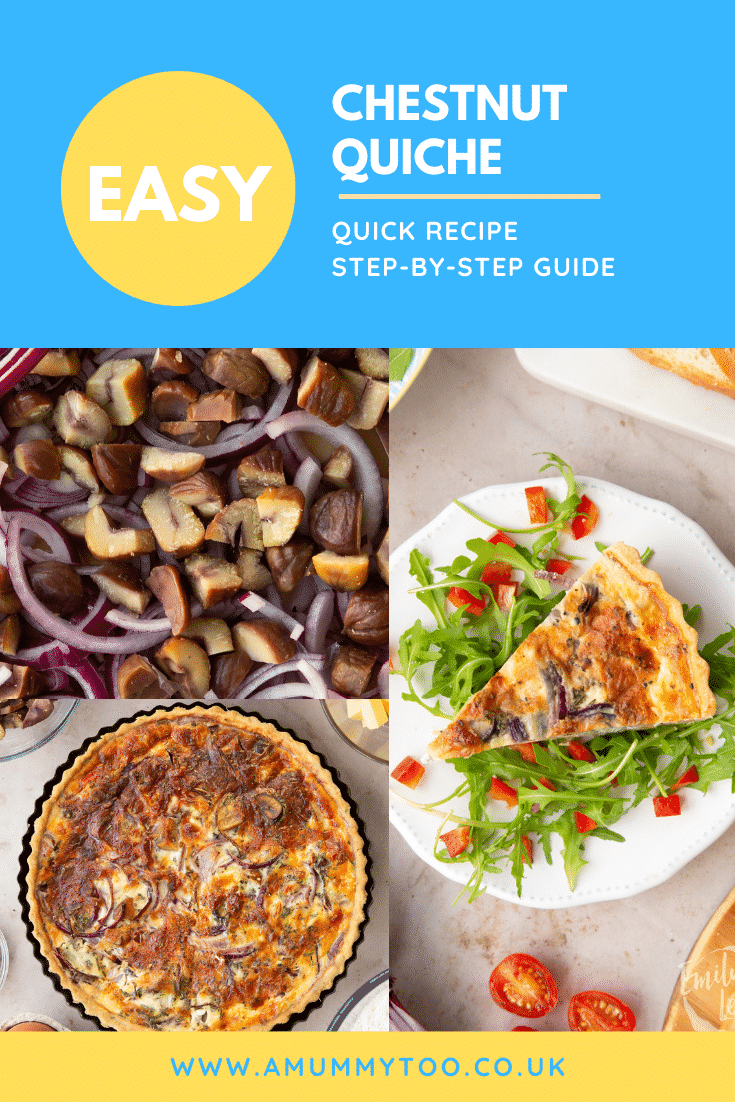
How can I tell if eggs have gone off?
It's always best to use fresh ingredients when baking, especially eggs. Eggs behave differently as they get older because they lose water content, which means an older egg will produce different results. So not only is it safer to use fresh eggs, but it will improve the quality of your food.
If you aren't sure if your eggs are fresh, you can do a float test to check them. A float test involves placing your egg in a cup or bowl of water to see if it sinks or floats.
As I said, when an egg gets older, the water content evaporates through the shell and is replaced by gas. So fresh eggs will have very little gas inside the shell, making them more likely to sink. However, this isn't a foolproof test as bad eggs can still sink.
You should never eat an egg that looks, smells, feels or tastes odd in any way. So if your egg has any discolouration, odd appearance, or a strange or foul odour, it is most likely rotten.
If your egg has spoiled, you should immediately throw it away and thoroughly wash any pots and utensils that have come into contact with it.
To ensure you don't contaminate a recipe with a bad egg, it's always best to crack your eggs into a separate bowl or cup before adding them to a recipe. This lets you check the egg for any broken shell fragments, but more importantly, it enables you to check that the egg is safe to use.
To avoid your eggs spoiling, you should always follow the storage instructions on the egg packet.
In the UK, it's recommended that eggs are kept consistently below 20C, which means it's best to keep them in the fridge at home. A home kitchen will fluctuate in temperature during cooking, Summer months or when the central heating is on. Eggs are kept on shelves in supermarkets because stores can regulate temperatures to remain below 20C even outside the fridge aisles.
Egg safety standards can vary depending on where you live, so storage and use advice can differ too. For example, if you live in a warmer country, you might find eggs in the refrigerated aisle and be advised to keep your eggs in the fridge.
Whereas, if you live somewhere colder, it might be acceptable to keep your eggs on the counter or in the fridge, and you'll find eggs on the ambient aisle.
In the UK, eggs have a "Best Before End" date stamped on the box and often on the egg itself. Most eggs sold in the UK are stamped with the Red Lion symbol, a safety standard you can read more about on the Egg Info website. You can eat Red Lion stamped past the Best Before End date, as long as you stored them correctly and there are no signs of spoilage.
In the United States, eggs have an Expiration Date. An Expiration Dates is a food safety date that you should always follow. So never eat an egg past its Expiration Date, even if it looks and smells fine.
It's important to note that these dates and guidelines are only valid if you store your eggs as the box advises you to. A Use By/Expiration/Best Before date is calculated for eggs tested and stored below a specific temperature. So if you keep your eggs on the counter instead of the fridge, they may have spoiled before the Use By date.
Food safety is especially important if you're in a vulnerable or at-risk group such as older people, people living with health conditions, or someone pregnant.
A Mummy Too does not give medical advice. Please consult with your medical professional.
How can I tell if butter has gone off?
Butter quickly spoils if kept somewhere warm or left exposed to the air. So you should only use butter which has been stored in the fridge.
When butter spoils, it turns a darker colour yellow rather than the pale creamy yellow. So you'll usually be able to tell if your butter has spoiled by looking at it. Butter also develops a strange smell as it deteriorates, with a slightly sour aroma, similar to spoiled milk. This is due to bacteria releasing enzymes in the butter, which break down the proteins and release sour-smelling lactic acid.
Sometimes you might not smell or see that butter has spoiled, so give it a taste before you use it. If the butter tastes sour, rancid, or fizzy, you should discard it immediately.
It's always best to use the freshest ingredients, especially dairy and egg, so you can make sure your food is of its best quality.
How can I tell if cheese has gone off?
When cheese gets older, it starts to dry out, crack, and turn a darker
colour. It also tends to develop a more intense aroma as it spoils. Cheddar should already have a mild, creamy scent, but if it smells 'tangy', then that's a sign that it has begun to spoil. The tangy smell is caused by lactic acid, which is produced by an enzyme bacteria releases to break down the fat and protein in cheese. So a tangy smell is a telltale sign that your cheese is off.
As cheese becomes more spoiled, it will develop blue, green, grey or even red mould patches. Many kinds of cheese contain mould, though it's cultivated and monitored to ensure that it's safe for consumption. However, the mould that appears on spoiled cheddar cheese isn't suitable for eating as it could contain harmful bacteria.
So if your cheddar looks a different colour, has cracks and dryness, smells different or has spots of mould, you should discard it immediately and wash anything it has touched.
How can I tell if milk has gone off?
When milk goes off, it begins to smell sour. Just like cheese, this sour smell is produced by lactic acid breaking down the fat and dairy protein.
So when milk is really old or in advanced stages of spoilage, it will even look chunky, as the lactic acid breaks down enough of the bonds between the fat and protein to cause curds to develop.
Sometimes spoiled milk will look and smell relatively normal, but it will taste off. So if you don’t have a good sense of smell, it’s best to give it a taste before using it, just in case it is spoiled.
If your milk tastes strange, smells strange or looks chunky - discard it and wash anything it has come into contact with!
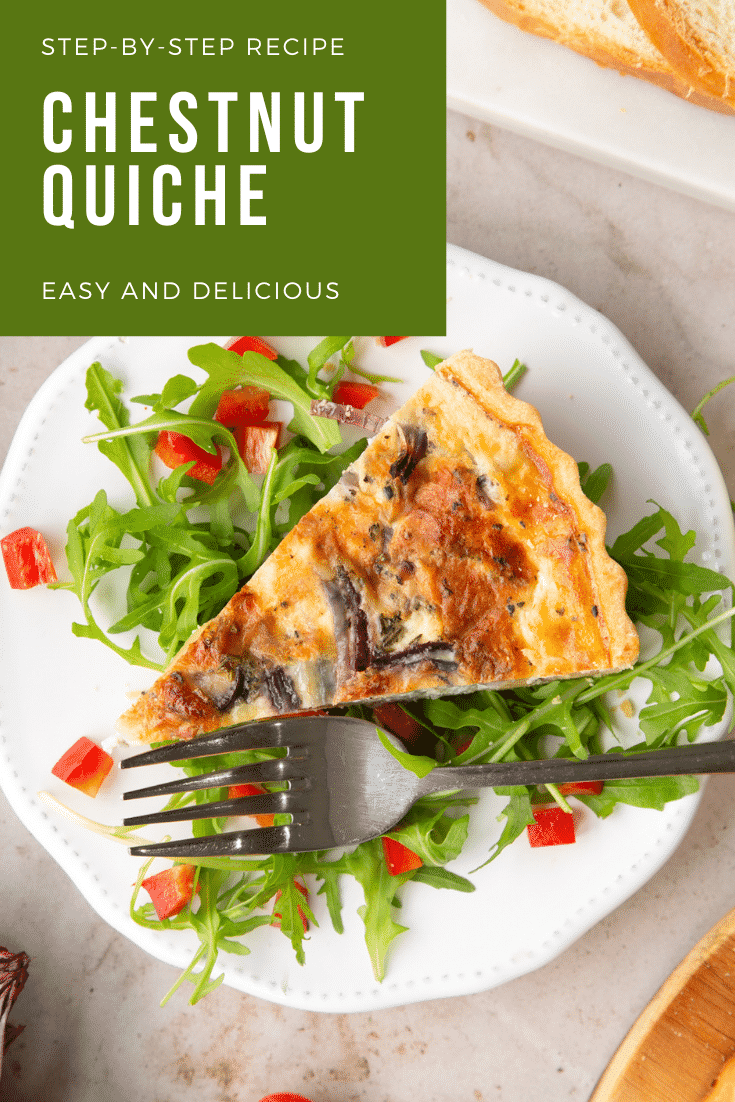
Is Chestnut quiche suitable for vegetarians?
Yes, this recipe is completely safe for a vegetarian, as long as you use a vegetarian cheese.
Some cheese manufacturers use rennet to create the curds that form cheese. While there are artificial versions of rennet, unfortunately, some manufacturers still use natural rennet, which comes from the stomachs of calves and other young animals. So this is why some cheeses aren't suitable for vegetarians.
However, there are many brands of cheese which don't use rennet, so you'll be able to find some in your local supermarket.
When you're cooking for someone with dietary requirements, you must double-check all of your ingredients labels to ensure that all of your ingredients are safe and suitable. Don't forget to check anything extra you intend to serve with your Chestnut quiche.
Is Chestnut quiche suitable for vegans?
No, this recipe for Chestnut quiche contains butter, dairy and eggs so it isn’t suitable for a vegan. Usually, I’d suggest ways to adapt a recipe for a different dietary requirement, but this recipe isn’t ideal to adapt as the result relies on eggs to hold the mixture together. So to make a vegan quiche I would need to test and write a completely different recipe!
Don’t worry though, the BBC has a recipe for a vegan quiche that uses tofu as a binding agent in place of egg. So if you wanted to try and make a vegan quiche this BBC recipe would be a good place to start.
If you want me to create a vegan quiche recipe then let me know in the comments below or drop me an email!
Is Chestnut quiche gluten-free?
No, this Chestnut quiche recipe isn’t gluten-free but it would be really easy to adapt for a gluten-free diet.
The only ingredient in this recipe that contains gluten is the flour in the pastry. Luckily, it’s a shortcrust pastry, which means it doesn’t rely on the gluten in the flour being activated. So you could substitute the plain flour with a gluten-free flour alternative.
There are loads of great quality gluten-free flours available in supermarkets or online. I would recommend using a blend, rather than a one ingredient flour alternative. Blends tend to contain ingredients like potato and xanthan gum, which work as binding and stabilising agents to help gluten-free flour behave similarly to wheat flour.
I often use this gluten free plain flour blend from The Free From Fairy. Though there are many other good quality gluten-free flour blends available in supermarkets or from Amazon.
Double-check all of your ingredients labels to make sure that they are gluten-free. Don't forget to check anything extra that you intend to serve the recipe with.
Is Chestnut quiche keto-friendly?
This recipe is almost keto-friendly. The only ingredients that aren't ideal for a keto diet are the pastry and the chestnuts.
A ketogenic diet limits you to 20g carbs per day to encourage your body to reach a state of ketosis. 'Ketosis' means that your body has begun to get energy from in your body fat instead of carbohydrates that you have consumed.
This process also impacts your blood sugar levels and the release of hormones used to process sugar, which is why the ketogenic diet is sometimes used to help manage diabetes.
Some fruits, nuts and vegetables contain natural sugar or carbohydrates, which isn't suitable for a ketogenic diet. So, unfortunately, the chestnuts in this recipe are too high in carbs for the keto diet, as is wheat flour.
Luckily, fat, dairy and protein are acceptable on a keto diet. So if you substitute the wheat flour for keto-friendly flour, there are a few kinds of keto-flours available online from keto stores or Amazon - Almond flour would probably work well here in terms of flavour.
Or, you could skip the pastry entirely and try my keto-friendly pepper quiche cup recipe - which uses bell peppers instead of pastry cases!
Is Chestnut quiche healthy?
It depends on your outlook! I think this Chestnut quiche is a healthy, hearty dish that provides you with calcium, vitamins, fats and fibre. Whereas to someone on a diet which restricts carbs or fat, this quiche would seem unhealthy.
Though overall, this is a relatively light quiche so I’d say it’s pretty healthy.
Is Chestnut quiche safe to eat while pregnant?
Yes, this Chestnut quiche is safe for a pregnant person to eat.
Everything in this quiche should be cooked through by the time it’s ready to serve, so as long as you make sure your quiche is correctly cooked it will be completely safe.
This recipe contains egg, which can be a risky ingredient for pregnant people if it isn’t safely prepared. As I said above, most eggs in the UK are produced to British Lion standards. This means that even if your British Lion eggs are undercooked, they will still be safe to eat even while pregnant.
However, not all eggs are produced to Red Lion standards, so it’s safest to make sure your quiche is cooked through properly before serving.
So when your quiche comes out of the oven, gently poke the centre with your finger. It should be ‘set’ and retain its shape if you prod it with your finger.
Fresh vegetables and some dairy can contain harmful bacteria if it isn’t cleaned or cooked properly. So when cooking for someone who is pregnant, or people in vulnerable groups, you should take extra care to ensure that all of your ingredients are in good, clean condition and you prepare food safely and hygienically.
A Mummy Too does not offer medical advice. Please seek help from a medical professional if you need further information or have any concerns.
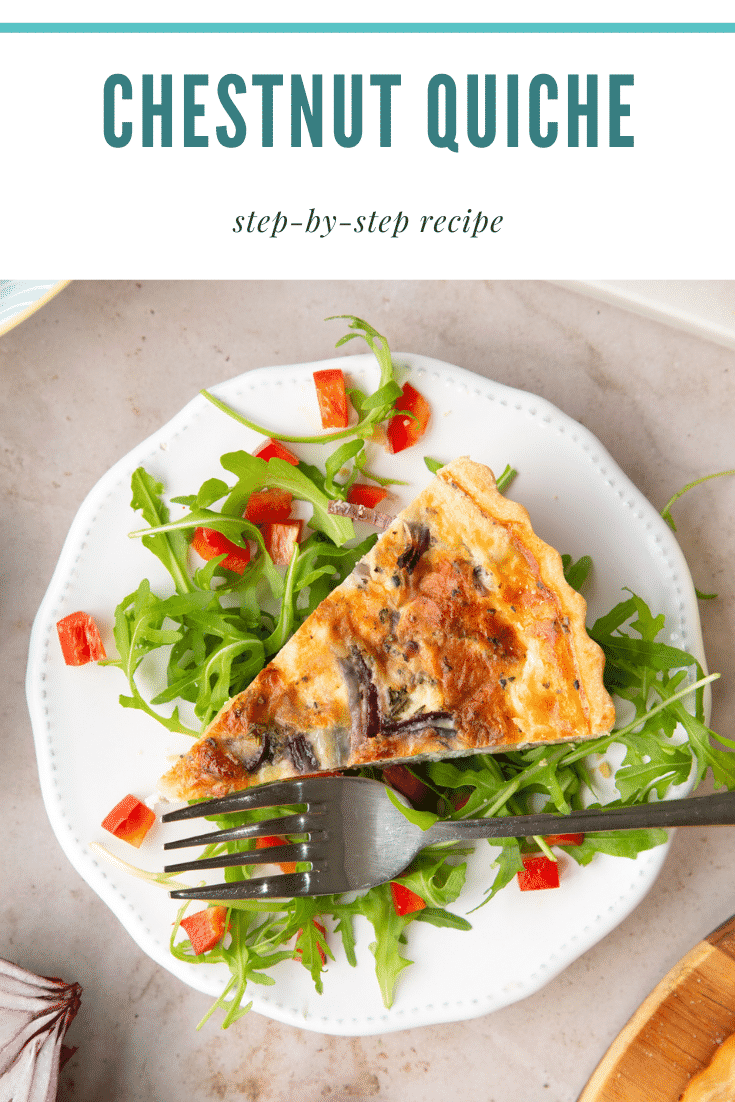
What goes well with Chestnut quiche?
Chestnut quiche would be perfect for a picnic, so I’d probably enjoy it with a fresh salad. If you’re making this recipe in the colder months, why don’t you make a warm salad to enjoy with this quiche fresh from the oven?
Can I make the Chestnut quiche without chestnuts?
Yes, feel free to make this quiche without the chestnuts. Though I’m not sure you would be able to call it a Chestnut quiche without the chestnuts!
If you leave the chestnuts out of the quiche you’ll just end up with a cheese and onion quiche. So if that sounds too plain you can add a steamed vegetable like broccoli, or some little pieces of cooked bacon.
How should I store Chestnut quiche?
Once your quiche is cooked, you should take it out of the quiche tin, let it cool and then transfer it to a lunchbox or sealable container for storage in the fridge. If you’re low on space you could even portion the quiche into slices and store it in a smaller container, in between layers of baking parchment.
You can also store your Chestnut quiche in the freezer if you want it to keep longer than a few days. I’ve detailed the best way to freeze your quiche below.
You shouldn't leave your quiche in the cupboard or out of the fridge or freezer as it will quickly spoil and become unsafe to eat.
How long does the Chestnut quiche recipe keep?
You can store your Chestnut quiche in the refrigerator or the freezer.
If you store your Chestnut quiche in the fridge, it should last for up to 4 days. Though you should make sure to keep it in a properly sealed container to ensure it isn't exposed to any contaminants.
If you store your Chestnut quiche in the freezer, it should keep for up to 3 months. I've included some tips for the best way to freeze your quiche in the section below.
The longer you store your quiche, the softer the pastry will become. So it's best to enjoy your quiche as fresh as possible.
Can I leave Chestnut quiche out on the counter?
No, if you leave your Chestnut quiche out on the counter, it will spoil and become unsafe to eat. Instead, you should keep your quiche in the fridge or in the freezer to ensure it stays safe and fresh.
Can I make Chestnut quiche ahead?
Yes, you can make Chestnut quiche ahead of time and keep it in the fridge or freezer. It will keep in the fridge for up to 4 days, but it’s better to serve it within two days of making it, otherwise, you might end up with soggy pastry.
Can I keep Chestnut quiche in the refrigerator?
Yes, the best place to keep your quiche is to store it in an airtight container in the fridge. It should keep for up to 4 days in the refrigerator, but it’s better to enjoy it as fresh as possible to avoid getting a soggy bottom!
Can I freeze Chestnut quiche?
Yes, you can freeze Chestnut quiche very easily! If you're making it for a party or picnic where you know you'll want to serve it whole, then freeze it whole.
However, if you're just freezing it to save leftovers, it's probably best to freeze individually wrapped slices to save on freezer space.
If you're freezing your Chestnut quiche whole, you could put the quiche onto a freezer-safe plate covered with foil and freeze it flat. If you're freezing your quiche in slices, you could wrap individual portions in foil and freeze them loose or within a sealed container.
It's best to wrap the quiche in foil to help reduce the chance of freezer burn. Freezer burn is the frosty layer that forms over frozen food as water evaporates as it freezes. So by reducing the amount of air around the quiche, you're reducing the chance of freezer burn developing.
What is the best way to defrost Chestnut quiche?
The best thing about storing your Chestnut quiche in the freezer is that you don’t need to defrost it! When you want to eat your frozen quiche just pop it in the oven under some foil and enjoy it as if it’s freshly baked!
Here’s a step by step guide for reheating your frozen Chestnut quiche:
- Preheat your oven to 175C.
- Place your frozen Chestnut quiche onto a baking sheet or into a baking dish and cover it with aluminium foil.
- Cook the quiche for 30 to 45 minutes or until the inside of the quiche is at 75C. I would test it after 30 minutes to see how it’s doing. Cooking time will vary depending on various factors, including how thick the centre is the distribution of water within the quiche filling
- Take your Chestnut quiche out of the oven and then let it sit for 15 minutes without removing the foil.
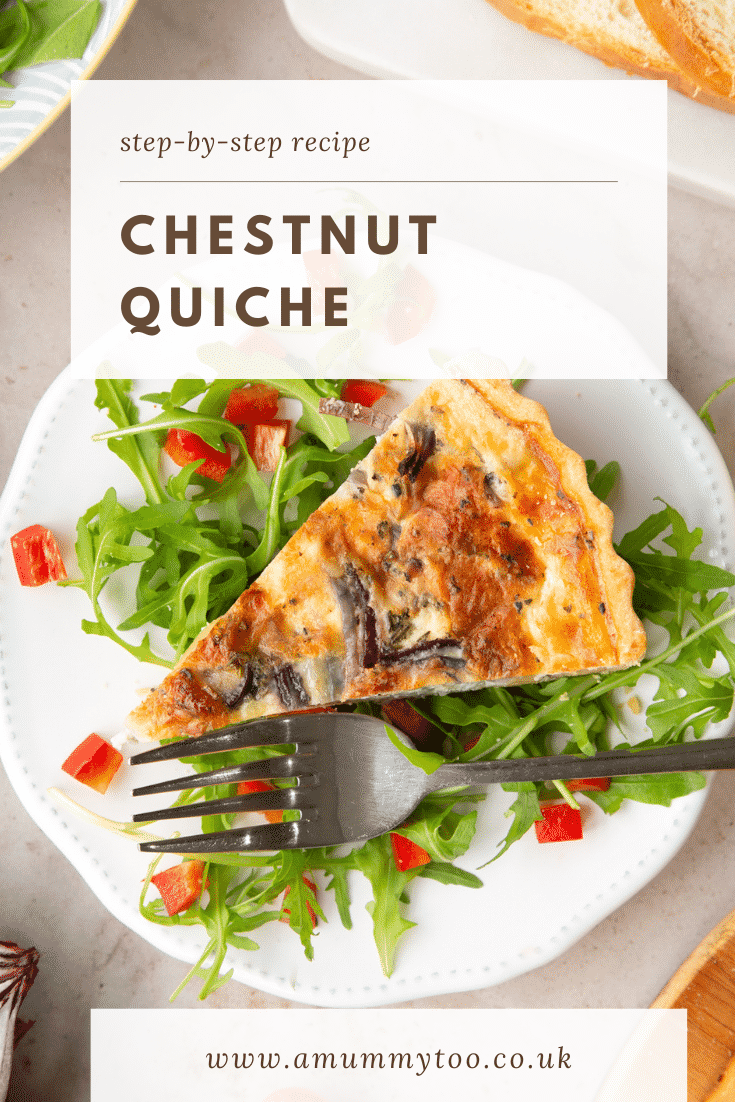
Can I make Chestnut quiche in a different size?
Yes! If you want to make a different sized quiche, I have a helpful tool in the recipe card below, which will help you change the ingredients and keep the same ratios.
Scroll down to the recipe card below, where you'll see the servings amount near the top. To change the size of your quiche, click on the number, and a little slider will pop up. Then you can drag the slider up or down to get the amount you want to make.
All the ingredient quantities will automatically update you so that everything is in the correct ratios.
If you make a bigger quiche, you'll need to cook the quiche for a little longer. If you extend the cooking time, it might be a good idea to reduce the temperature by 10 degrees to avoid the top of the quiche burning before the centre cooks through.
As I said above, when your Chestnut quiche is cooked, it should be firm in the centre. So if you make a larger quiche, give your quiche the 45-60 minutes cooking time as this recipe states, then take it out and poke the centre to see if it has 'set'.
If you make a smaller quiche or individual quiches, you'll need to reduce the cooking time. Again, reducing the cooking temperature by 10 degrees might be safer to avoid the pastry cases or quiche surface from burning.
You can judge each cooking stage in this recipe by eye and touch, so if you change the size or quantity of this Chestnut quiche recipe, make sure you monitor every step closely.
Good luck!
Can I make this recipe in a different tin/tray?
Yes, feel free to make your Chestnut quiche in a different tin or tray, but keep in mind that a different shape or depth will affect the cooking time.
So if you do use a deeper quiche tin, you should extend the cooking time and reduce the temperature or cover your quiche in foil to protect the surface from burning before the centre is cooked.
However, I haven't made this quiche in a different shape or size, so I can't be certain how successful it would be.
Can I make Chestnut quiche in a stand mixer such as a KitchenAid or Kenwood Mixer?
There isn't really any stage in this recipe where a stand mixer would be helpful. The pastry doesn't need kneading, and the filling ingredients only need to be added to the pastry case. So using a stand mixer would just create extra washing up!
Can I make Chestnut quiche with a food processor?
Again, there isn't much need for a food processor for this recipe. You could use a food processor to quickly blitz your flour and butter together to create the crumb for the pastry. However, make sure it's just a quick blitz - you don't want to mix your flour and butter into a paste accidentally.
How can I make sure my Chestnut quiche turns out perfectly?
To get a perfect Chestnut quiche, you'll need to prepare well and pay close attention to a few points in the recipe.
First, as with every recipe, I recommend weighing and measuring all ingredients in advance. If you have everything prepped and measured out before you begin cooking, you'll know exactly what you need without having to work out measurements while mixing.
I find it helps to place everything in the order you're going to add it to the recipe, so you know if you miss a step or ingredient.
Once you start cooking, you’ll need to watch these points:
Pastry:
- Don’t overmix your pastry. You only want to bring the ingredients together to create a lovely crisp shortcrust pastry. If you knead your pastry or overmix it in a food processor you risk activating the gluten which will produce a dense, chewy pastry.
- Blind bake your pastry properly. Blind baking your pastry properly helps ensure the pastry doesn’t get soggy when you cook the full quiche. So make sure that you blind bake your pastry shell properly. It should feel ‘set’ in the centre and dry/cooked around the edges. If you overcook your pastry case during the blind baking stage, it will come out burned when you cook the quiche. If you undercook your pastry case, your quiche will be soggy. So it’s an important step to get right!
- Baking beans: Another point to watch while blind baking is to make sure you put baking parchment down before adding your baking beans/rice. Otherwise you’ll end up picking out pieces of rice and beans from your pastry!
Assembled quiche:
- Even distribution: Evenly distribute your onion and chestnuts in the pastry case. This will help the quiche cook evenly and make sure everyone gets the tastiest slice possible.
- Rosemary: Make sure you remove the stalks from the rosemary so you don’t end up chewing on twigs!
- Eggs and milk: Whisk your eggs and milk together well so you don’t have uneven areas of milk, egg whites and yolk.
- Don’t overfill: Depending on the depth or size of your quiche tin, you might not need to use all of the milk and egg mixture. You should fill the pastry case until there’s a 1cm space at the top. The egg will expand during cooking, so if you overfill the quiche it will most likely spill over the edges and leak all over the oven.
Why did my Chestnut quiche turn out dry/crumbly?
If you take your quiche pastry shell out of the oven after blind baking it and it’s crumbly and dry, then it sounds like there wasn’t enough butter or water added to the pastry mix. ]
It only takes a little extra flour to cause crumbly pastry, so it’s really important to make sure you get the exact amount and ratio of ingredients. As I said above, to avoid this happening again you should weigh and measure out all of your ingredients before you begin cooking, including water.
Why did my Chestnut quiche turn out wet/soft?
Your Chestnut quiche should have a set, creamy filling and a crisp pastry casing. So if your filling is too wet or your pastry is soggy, then it sounds like something has gone wrong.
Before you cook the assembled quiche, you'll blind bake your quiche. Your blind-baked pastry should come out of the oven crisp around the edges and a cream/ pale gold colour. The centre should be set, but it might be a little doughy still.
If you undercook your pastry during the blind baking stage, it will absorb moisture from the quiche filling and become soggy. So make sure you blind bake your pastry properly to avoid a soggy bottom.
If you've baked your quiche and the filling is still wet, all you need to do is return it to the oven with some foil over the top and cook it for another 5-10 minutes, depending on how wet it is. Repeat the process until the centre is set and the quiche feels cooked.
The tinfoil should help to protect the pastry from burning, but it might turn a darker brown if your oven is very hot.
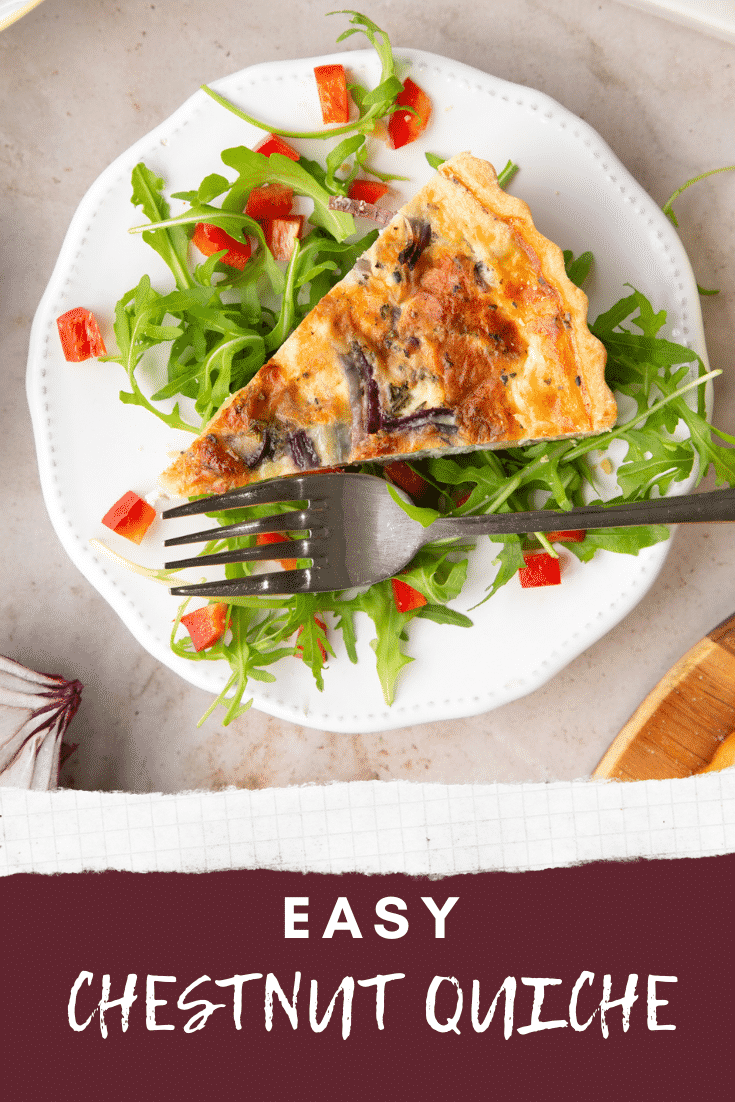
How can I add/change the flavours in the Chestnut quiche?
Quiche is really easy to change or add flavours to, so there are a few ways to do it.
If you aren't a chestnut fan, I have a few other quiche recipes on the site - like this Broccoli and pepper quiche.
If you want to add flavours to complement the chestnuts and egg in this recipe, you could try adding some spices or extra herbs to the filling, and it wouldn't affect the cooking time.
You could add some festive spices like cinnamon and nutmeg or herbs like thyme and sage if you're making this quiche during the Christmas season. Nutmeg and thyme work really well with eggs too.
You could also swap out the cheddar cheese for another cheese with similar water content. I say a 'similar water content' because a watery cheese like mozzarella or ricotta would release more water during cooking and produce a soggy quiche.
Print this chestnut quiche
Chestnut Quiche Recipe
Ingredients
For the pastry
- 200 g (7.1 oz) plain white flour (all purpose flour) all purpose flour
- 100 g (3.5 oz) slightly salted butter
- 2 tbsp water
For the filling
- 180 g (6.3 oz) whole chestnuts quartered
- 1 red onion thinly sliced
- 5 g (0.2 oz) rosemary stalks removed, finely chopped
- 4 medium free range eggs
- 300 ml (10.1 floz) whole milk
- 40 g (1.4 oz) cheddar cheese vegetarian if required grated
Instructions
Make the pastry case
- Put the flour and butter into a bowl. Rub together quickly and efficiently until you have something resembling fine breadcrumbs. You can do this by pulsing in a food processor, if you prefer.
- Add the 2 tbsp of the water and cut the liquid through the crumb with a cutlery knife. If it still seems really dry, add another drop or two but try not to add more as a wet dough may result in a tough pastry or a soggy bottom.
- Shape the pastry quickly into a flat disc, wrap and pop in the fridge for at least 10 minutes to firm up.
- Preheat the oven to 210C (190C fan-assisted).
- Roll out the pastry so that it’s 3-5cm (1-2 inches) wider than your tin. Lift it into the tin, press into the corners so that there are no air gaps. Roll a rolling pin over the top of the tin to trim off the excess.
- Scrunch up some baking paper and use it to closely line the inside of the pastry case.
- Fill the paper with baking beans making sure to work them into the corners.
- Place the tin in the oven and bake for 15 minutes. Lift out the baking paper with the beans (careful, they’ll be very hot) and have a look at your pastry. It should look dry at the sides but will probably still be a bit doughy on the base.
- Return to the oven for a further 5 minutes until it looks dry all the way across. If there are any air bubbles on the base, you can gently smooth them down with the back of a spoon.
Make the filling
- Lower the oven temperature to 190C (fan 170C) and place a flat tray on the shelf (this will help ensure the base is well crisped.
- Spread the red onion and chestnuts evenly on the bottom of the pastry case.
- Sprinkle the grated cheese on top, then the rosemary and a good pinch of salt and pepper.
- In a jug, beat the eggs and milk together.
- Pour the egg mixture into the case. Depending on the size of your tin, you might not need all of the egg and milk mixture. Don't fill it closer than a centimetre or so (half inch) from the top.
- Bake for 45-60 minutes until the pastry is crisp and golden and the quiche feels set to the centre if gently pressed with a finger tip.
- Place the flan tin on a can and the sides should drop away. Transfer the quiche to a cooling rack.
Nutrition
Pin this chestnut quiche
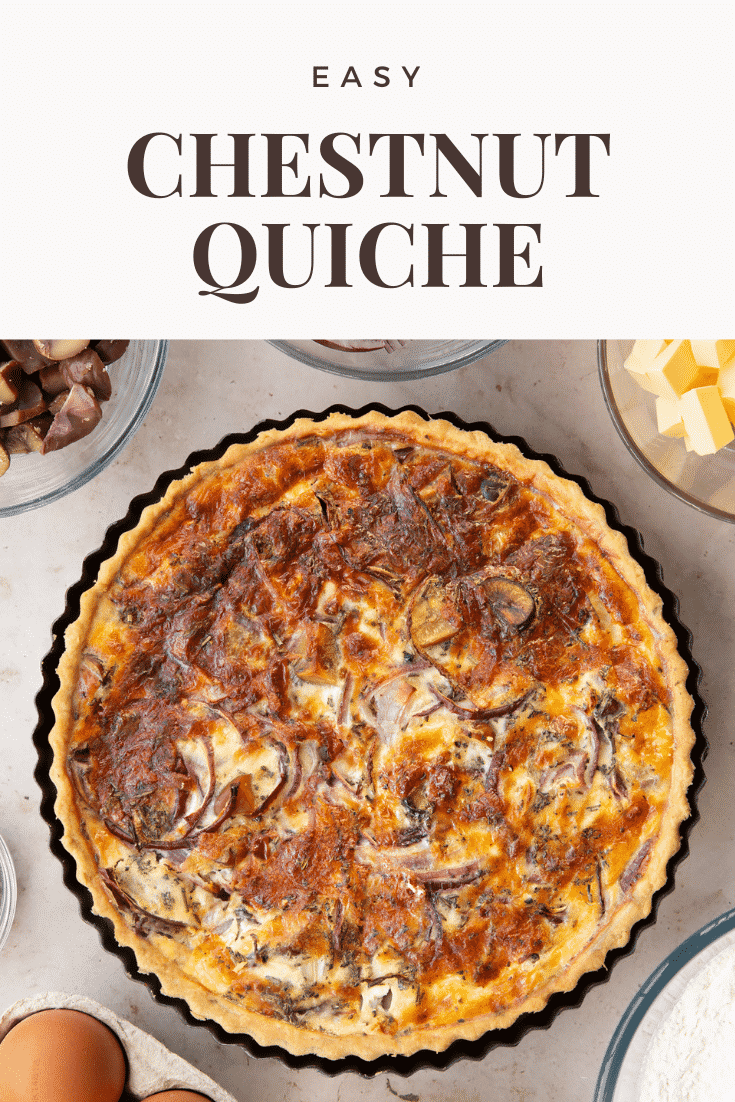
More quiche recipes to try
Have you got my book?
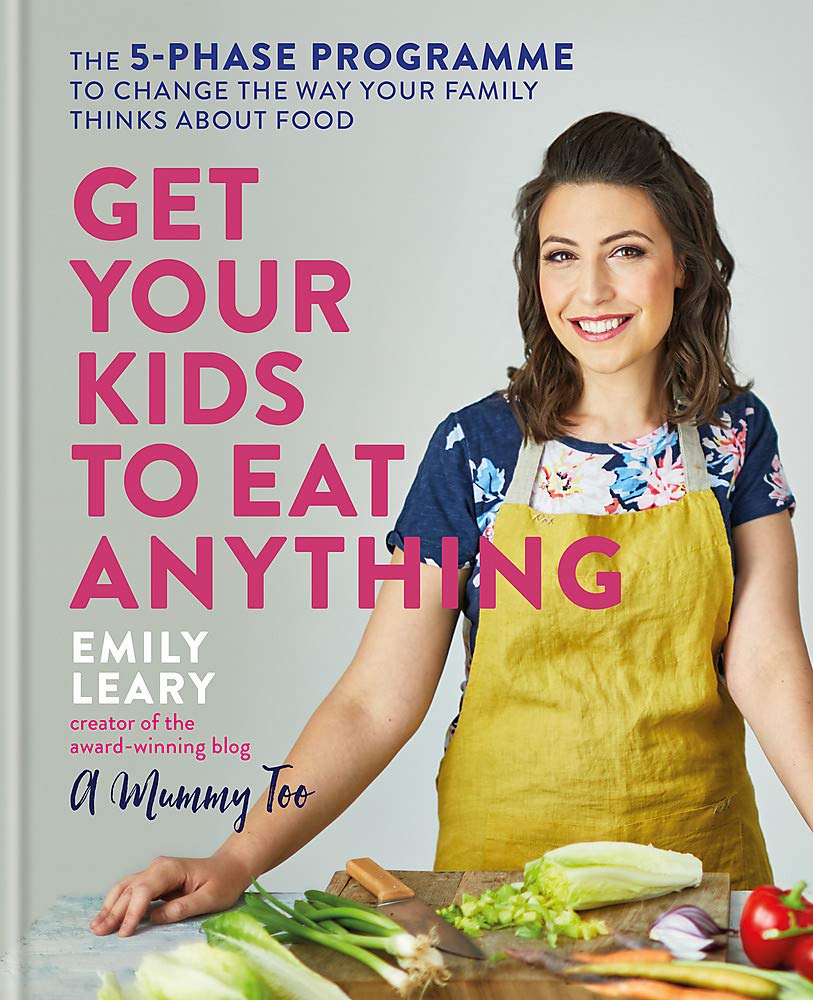
'This is a great kids cookery book. Emily is a star' - Simon Rimmer
'The book I'd like to force into any mother's kitchen' - Prue Leith
"A fab book with a plan." - Jane Devonshire, 2016 Masterchef UK winner
'Emily has managed to combine her mummy knowledge and passion for food to make a truly helpful and brilliant cookbook' - Priya Tew, RD, BSc (Hons), Msc
Get Your Kids to Eat Anything is an achievable 'how to' for parents in the battle to overcome picky eating and 'make new the norm'. Emily Leary's unique 5-phase programme looks at the issue of 'fussy eating' in a holistic way that links imagination with food, and which situates parents alongside - not in opposition to - their children.
.


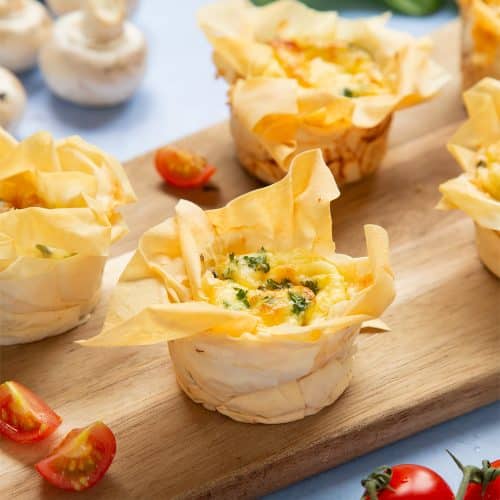
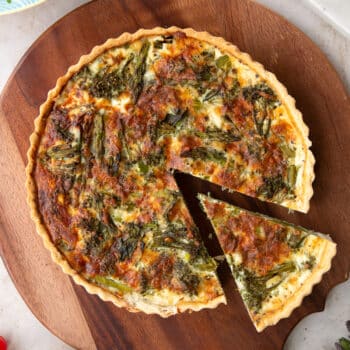
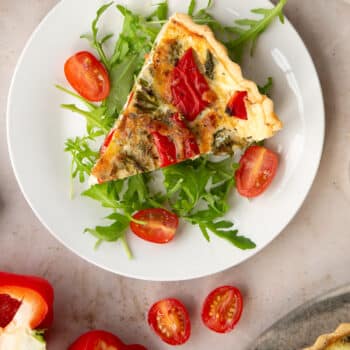
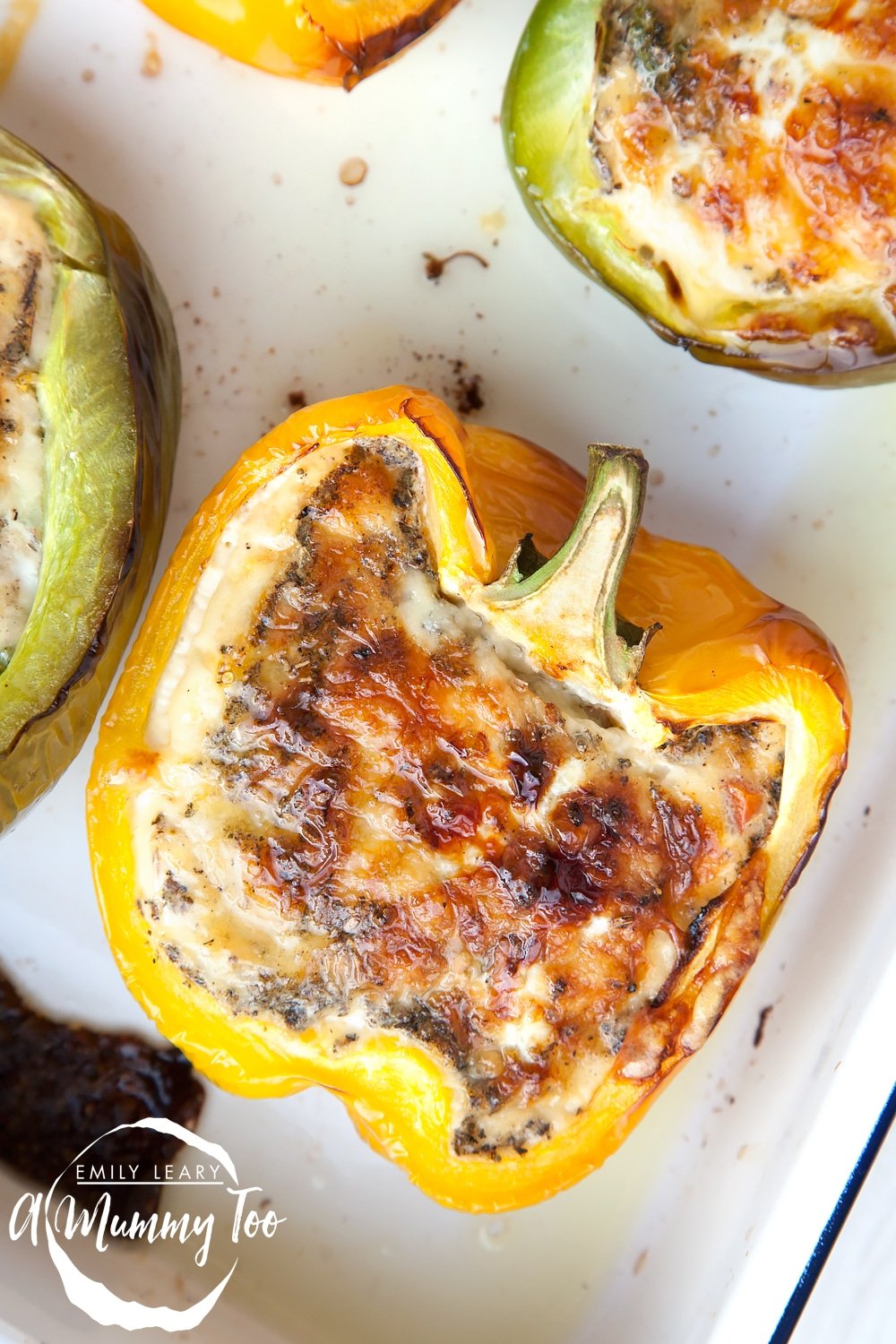

Charlie says
This looks gorgeous! I've never made a quiche before and don't have a tin, what size tin did you use for this recipe? Thank you x
Emily Leary says
Hi. Good question! I used a 9 inch, loose bottomed, non-stick, fluted quiche tin. I've added that to the ingredient list to make it easier for future readers. Thanks for asking :)